Discover the stocks and sectors driving these big global indices and more

VOL 25 / ISSUE 33 / 24 AUGUST 2023 / £4.49
FTSE 100 S&P 500 NASDAQ







13
• Market faces up to ‘5% world’ ahead of Powell’s Jackson Hole appearance
• Why Intel’s blocked Israeli chip deal could pose threat to technology M&A
• VinFast zooms on to US market as investors pick holes in Tesla’s China strategy
• Strong domestic economy and improving balance sheet see Bank of Georgia shares surge
• Barbenheimer can’t even save Everyman Media with the shares down 30% so far in 2023
GREAT IDEAS
New: Begbies Traynor / Evenlode Income Fund Updates: Keurig Dr Pepper



16 FEATURE How concern over private holdings has pushed RIT Capital’s discount to 20%
20 FEATURE FTSE 100, S&P 500, Nasdaq: Discover the stocks and sectors driving these big global indices and more

30 ASK TOM Can a natural yield strategy sustain me in my retirement?

32 FEATURE How to analyse Lloyds Banking in five easy steps

38 FEATURE Why Premier Foods’ growth prospects are exceedingly good
Is China about to face its Minsky moment as country’s property crisis intensifies?

24 August 2023 | SHARES | 03 Contents 06 NEWS
MOULD
48 EDITOR’S VIEW How
50 PERSONAL FINANCE Understand the basics on inflation and how interest rates help curb it 53 INDEX Shares, funds, ETFs and investment trusts in this issue 20
38 15
32
45 RUSS
AI could lead to a big transformation in the hotels industry and other sectors
4548
30
FTSE100 S&P500
NASDAQandDiscoverthestockssectorsdrivingthese bigglobalindicesandmore
W hetheryou’resavingforretirement,

Aprilcreation.AccordingtodatafromBloombergfrom


returns57.3%overthepastfiveyears,smashingthe fromcashandbondsdespitetherecent orcycleofinterestratehikesoverthepast18months Thisso,typicallygoodforthelattertwo.duringaperiodofchaoscreatedbya globalpandemic,anewwarinEuropeandother safedestabilisingevents.Gold,theultimateinvestor Ashaven,increased66.7%overthesameperiod. thechartoverleafshows,thisoutperformance noofequitiesovercash,bondsandcommoditiesis 20-yearone-off–it’sthesamestoryover10,15and timeframes.
EQUITIES HAVE OUTPERFORMEDMASSIVELY
Lookingatitanotherway,usingahypothetical theexample,ifyoucouldhaveinvested£10,000in investmentglobalequitiesmarket20yearsago,your wouldbeworthmorethan£71,000 today.That’smorethanthreetimestheamount

Howtoanalyse inLloydsBanking fiveeasysteps
Feature:AnalysingLloydsbanking


ByStevenFrazerNewsEditor
FTSE 100, S&P 500, Nasdaq
thanyouwouldhavehadfrominvestinginbonds,more nearlyfourtimesasmuchfromcommoditiesor £10,000fivetimesasmuchasifyouhadkeptthat inadepositaccount. haveButasmostofusalreadyknow,shareprices mightanastyhabitofgoingdownaswellasup.This competitionbebecauseofadryspelloftrading,stiffening inkeymarkets,pooruseofcapital, things,widermacroeconomicissuesorathousandother andsometimesitisnoteasilytoexplainwhatorwhy. yourThat’swherediversificationcomesin.Spreading moneyacrossmanyequitiescanhelpsmooth theupsanddownscomparedtobackingsingle stocksandinvestinginstockmarketindicesviaETFs way(exchangetradedfunds)isaneasyandlow-cost Whentogetinstantdiversification.youspreadyourinvestmentsaround, you’reincreasingtheprobabilityofcapturing thestocksthatdowell,andtheideaisthatthey compensateforanythatdon’tperformaswell.In theory,investingin100stocksshouldevenoutthe justreturnscomparedtoputtingallyourmoneyinto betteronestock,andinvestingin1,000shouldbe than100.Similarly,ifyouonlyinvestinthe stocksofonetypeofcompany,let’ssaythemajor manysupermarketsintheUK,itdoesn’tmatterhow youinvestiniftheyallperformthesame.If theonegoesup,theymayallgoup,andthesameon differentMeaningfulwaydown.diversificationrequiresinvestingin typesofcompanies,ofdifferentsizes,andgoesfromdifferentpartsoftheworld.Everycountry throughcycles,whereitseconomyexpands foraperiodoftimeandtheneventuallycontracts beforerecoveryandexpansionkicksinagain.
Get all the important facts about these and other big global indices, discover the stocks and sectors which move them

IstheUK’sbiggestlenderasmart investmentrightnow?A sthisisthelastinstalmentinour wefivestepstockanalysisseries(and andwouldencourageyoutogoback

andwe’vedecidedtodosomethingabitdifferent measuresexamineabank.Thismeansusingdifferent ofprofitability,returnsandvaluation. Toanalyseabank,youneedtounderstandwhat itdoes,howitusesitsbalancesheettomake moneyandthequalityofitsassets. newsWhilethismaysoundabitdaunting,thegood ismostbanksdothesamethingsoonce youhavelookedatonethechancesareyoucan transferthoseskillstolookingatothersandstart makingcomparisons.
Analysing Lloyds

STEP ONE: NET
MARGININTEREST
Three important things in this week’s magazine 1 2 3
Feature:PremierFoods

Atitscore,bankingisquitesimple:youborrow termmoneyfromdepositorsatonerateonashortlong-termbasisandlenditoutatahigherrateona basis. deposits,Bychargingmoreonloansthanyoupayon youmakeaspreadknownasanetinterestmargin. byThesizeofthenetinterestmarginisdetermined rates,severalthings,includingbackgroundinterest attractthebank’sbrandpoweranditsabilityto depositorsandborrowers,andthelevelofcompetition.




Chart:Sharesmagazine•Source:LloydsBanking,BankofEngland.Note:Baserateprevailingattheendofeachquarter
Five steps to understand the investment case behind the high street bank including net interest margin, costs to income and valuation
Visit our website for more articles
Did you know that we publish daily news stories on our website as bonus content? These articles do not appear in the magazine so make sure you keep abreast of market activities by visiting our website on a regular basis.

Over the past week we’ve written a variety of news stories online that do not appear in this magazine, including:
Sharesdiscussesbrands,balance sheetrehabilitationandoverseas growthspicewithfinancedirector
ODuncanLeggett
neofShares2023TipsofTheYear Mr.Kipling,Bisto,Sharwood’sand AmbrosiabrandsownerPremierFoods’ (PFD)stockisup11.5%year-to-date,extendingfive-yeargainstonigh-on190%. recentRavenousinvestorappetiteforthesharesin yearsreflectstheconsiderableprogress madeinreducingdebtandresolvingitspension

The Big Interview –Premier Foods
issues,aswellasthe consistentgrowthfromits brandsandcycleofforecast upgradesservedupunder thestewardshipofCEOAlexWhitehouse,notto mentionawelcomereturntothedividendlistafter alengthyabsence. TheFTSE250foodmakerhasrepaidourfaith yearwithapositivereturnthisyearthankstostrongfull results(18May)showingtradingprofitgrowth of11.5%,aheadofupgradedguidance.Premier Foodsfollowedthisupwitharobustfirstquarter tradingupdate(20July),whichrevealeda21.1% BistoriseingroupsaleswithcorebrandslikeBatchelors, consumersandOxotakingfurthermarketshareascookmoreathometokeepcostsdown. recentSignificantly,PremierFoodsalsosaiditbelieved highinputcostinflationwas‘pastitspeak’,meaningithadnoneedtoraisepricesagain thisyear.Andwiththequarter’sstrongsales momentumsettocontinue,fullyeartradingprofits shouldbeatthetopendofmarketexpectations. BrokerNumisrecentlyarguedPremier’s
Find out about the transformation of the food producer’s prospects in this chat with finance director Duncan Leggett
04 | SHARES | 24 August 2023 Contents
30 SHARES 24August2023
readpartsone twoand
three
Netinterestmargin 1.0 2.0 3.0 4.0 5.0% 1Q18 2Q18 3Q18 4Q18 1Q19 2Q19 3Q19 4Q19 1Q20 2Q20 3Q20 4Q20 1Q21 2Q21 3Q21 4Q21 1Q22 2Q22 3Q22 4Q22 1Q23 2Q23 Netinterestmargin BaseRate
38 SHARES 24August2023
Shareprice: 121.8p Marketcap: £1.07 billion Listing: FTSE 250 THEBIG NTERVIEW 20 SHARES 17August2023
WhyPremierFoods’growth prospectsareexceedinglygood
PREMIERFOODS(PFD)
anylookingtopayoffyourmortgageor otherfutureobjective,investinginequitieshasbeenoneofthe mostsuccessfulwaysofgeneratinglong-termvalue
2023,globalequities,representedbythe byFTSEAll-WorldTotalReturnIndex,havegrown
July retail sales slump on wet weather but hospitality sector shines
John Wood Group brings shareholders cheer with increase in full-year guidance
Crest Nicholson profit warning triggers another wave of selling in housebuilders
BAE Systems makes foray into space with $5.6 billion Ball Aerospace buy
Capital at risk.
That’s the sweet sound of taking control of your investments with AJ Bell.



Market faces up to ‘5% world’ ahead of Powell’s Jackson Hole appearance
While a pre-earnings surge for Nvidia (NVDA:NASDAQ) shares may have helped US stocks snap their recent losing streak, there’s no doubt concerns about interest rates staying higher for longer have helped temper market sentiment.
US 10-year treasury yields hit a 16-year high of 4.35% amid continuing signs of US economic strength, and minutes from the latest Federal Reserve meeting reinforced the market’s fears with the Fed still citing inflation upside risks which might necessitate further rate hikes.
Investors will have to wait until 20 September for the Fed’s next decision but a clue to the thinking of the world’s most important central bank should come at the Jackson Hole Economic Symposium which kicks off today (24 August).

Held in Wyoming, this annual summit of central bankers is closely monitored by traders and investors for clues on the future direction of monetary policy. European Central Bank chief Christine Lagarde and officials from the Bank of England will be present but the man most in the spotlight will be Fed chair Jerome Powell who is due to address the conference on 25 August.
US vs UK CPI
10-year treasury yield
In the meantime, Bank of America says most investment portfolios still hold too many assets which are priced for a ‘2% world’. The investment bank argues we are moving to an ‘age of scarcity’ marked by rising debt burdens, ageing populations and a move away from globalisation which will push inflation, growth and interest rates back to 5% norms or in other words a ‘5% world’.
The UK is some way behind the US in its own battle against inflation and figures for July weren’t too encouraging as, despite easing, inflation came in a smidge higher than anticipated at 6.8% (16 August). Core inflation remains unhelpfully sticky at an unchanged level of 6.9% and, combined with the record level of UK wage growth reported on 15 August, puts the Bank of England under pressure to deliver at least a 25 basis point (0.25%) increase at its next meeting on 21 September. [TS]
News 06 | SHARES | 24 August 2023
US economic strength heightens concern about rates staying higher for longer
(%) 2022 2023 1 2 3 4 Chart: Shares magazine•Source: Refinitiv
US
(%) 20192020202120222023 0 2 4 6 8 10 US CPI UK CPI Chart: Shares magazine•Source: Refinitiv
Why Intel’s blocked Israeli chip deal could pose threat to technology M&A
Chinese regulator could become a major obstacle for getting deals signed off
US technology firm Intel (INTC:NASDAQ) has pulled the plug on plans to acquire Israeli chip maker Tower Semiconductor after the deal failed to get regulatory approvals from Chinese authorities, a move that ups the ante in the technology battlefield between Washington and Beijing.
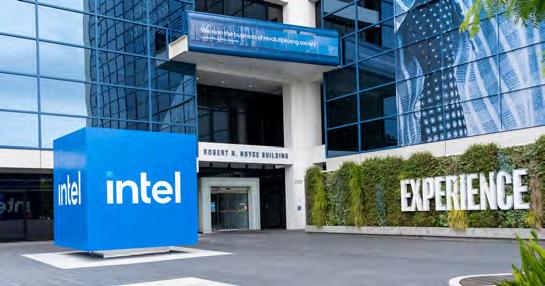
China’s regulator – the SAMR (State Administration of Market Regulation) – approves mergers if one of the companies has significant business interest in the country. Intel operates factories in China, and the country is one of its biggest markets. California-based Intel made almost $23 billion of revenue from China in 2021.
While the parties involved did not communicate any further details about the regulatory issues that tanked the deal, Reuters has reported that China failed to give the required approvals in retaliation against Washington’s export restrictions on advanced microchip technology.
The clash between the world’s leading superpowers over technology intellectual property has been bubbling away for over a year, and China’s latest move could hint at Beijing’s SAMR becoming an increasingly important actor in major acquisitions in future.
And Intel’s experience suggests a growing risk for
the M&A ambitions of other US tech firms which could be caught up in the growing enmity between the two nations.
In September 2022, the US Chips and Science Act was signed into law, prohibiting US chip companies from getting financed to build semiconductor plants in China for 10 years. In August 2023, US president Joe Biden escalated powers to block scuttle involving semiconductors, quantum computing technology and artificial intelligence systems in ‘certain countries of concern’.
With the Tower acquisition, Intel CEO Pat Gelsinger had envisioned investing more in the foundry market, a fast-growing segment of the semiconductor industry dominated by Taiwan Semiconductor Manufacturing Company (0981:HK). It forms part of Gelsinger’s strategy to accelerate Intel’s revenue growth and improve profits quality.
In 2022, Intel reported a 20% drop in revenue to $63 billion and operating profit collapsed, from a little more than $22 billion in 2021 to $2.3 billion.
Stuart Pann, the senior vice president and general manager of Intel Foundry Services (IFS), said in a statement that since its launch in 2021, IFS has made significant advancements toward becoming the second-largest global external foundry by the end of the decade.
Intel plans to go beyond traditional wafer manufacturing and include ‘packaging, chipset standards, and software’.
Intel stock, which has rallied 24% in 2023, has lost around 10% since the start of August, trading at $33.14, valuing the company at approximately $139 billion. [SF]
News 24 August 2023 | SHARES | 07
Intel ($) Oct 2022 Jan 2023 AprJul 25 30 35 Chart: Shares magazine•Source: Refinitiv
VinFast zooms on to US market as investors pick holes in Tesla’s China strategy
The world’s largest EV market is also the most cut-throat
Shares in EV (electric vehicle) maker Tesla (TSLA:NASDAQ) slumped last week on the announcement the company would cut prices again in China, the number one market for its products.

Just last month, the US firm and 15 of its Chinese rivals signed an agreement promising to compete ‘fairly’ with each other and refrain from what the government called ‘abnormal’ pricing.
Yet two days later the commitment was withdrawn by the Chinese auto makers’ association claiming it violated anti-monopoly rules, so the race to the bottom in pricing has re-started.
China’s EV market is forecast by local firm Daxue Consulting to be worth close to $300 billion this year and is expected to grow by around 6.4% per year by value through to 2028 led by BEVs (batteryelectric vehicles), such as those made by Tesla, which currently make up two thirds of the market by value.
Elon Musk, Tesla’s mercurial chief executive, warned investors last month there could be more price cuts claiming ‘it does make sense to sacrifice margins’ in order to sell more vehicles and protect the firm’s market share.
The firm described the second quarter of this year as ‘a record on many levels with our best-ever production and deliveries and revenue approaching $25 billion’ and enthused over the prospects for its Autopilot function and new product development.
However, it glossed over the fact its group operating margin had sunk below 10% for the first time since the beginning of 2021 and vehicle sales had lost momentum, registering $21.2 billion or less than in the final quarter of 2022.
While investors understand that China is a key market for Tesla, the prospect of sacrificing margins for the sake of shifting more vehicles doesn’t sit easily.
There are more than 90 Chinese EV makers
and more than 300 models on sale, so it’s no surprise that established brands like BYD (BYD:NYSE), Wuling (0305:HKG), Chery, Changan and GAC, together with new arrivals like Nio (NIO:NYSE) and Xpeng (XPEV:NYSE), still control more than 80% of the market.
Now there is a new kid on the block in the shape of Vietnam’s VinFast (VFS:NASDAQ), which recently merged with a SPAC (special purpose acquisition company) and listed on the US Nasdaq exchange and despite being loss-making is worth more than Ford (F:NYSE) or General Motors (GM:NYSE) in terms of market cap.
Unlike other new arrivals like Lordstown and Faraday (FFIE:NASDAQ), which have struggled, VinFast has been making cars for five years and has around 20,000 vehicles on the road.
‘We’ve got every step from product development to supply chain’, the firm’s says the chief executive, claiming VinFast would be profitable ‘in the next couple of years’. [IC]
News 08 | SHARES | 24 August 2023
Tesla 11.8.13.8.15.8.17.8. 0 10,000 20,000 30,000 40,000 50,000 60,000 70,000 80,000 VinFast market value $m Ford Motors market value $m General Motors market value $m
Chart: Shares magazine•Source: Refinitiv
Strong domestic economy and improving balance sheet see Bank of Georgia shares surge

Shares in the European lender hit a new high after the firm posted a big increase in first-half profits
Shares in Bank of Georgia (BGEO) are 171% higher than they were three years ago and up more than 20% in just the last six months to all-time highs of nearly £36.
More good news if you are a shareholder is that the European lender has raised its interim dividend by 65% to 3.06 lari (0.92 pence) per share, while the board has approved a further 62 million (£18.6 million) of share buybacks.
Improvements to its balance sheet, a growing Georgian economy – with GDP up 7.6% year-onyear – have both played a role in making this stock one of the best performers since the pandemic, considerably outshining its UK banking peers.
The Tbilisi-based bank reported an impressive 39% surge in net interest income for the six months to 30 June to 768 million lari (£230 million) and a 44%
increase in net fee income to 201 million lari (£60 million).
Broker Peel Hunt said the profit was ahead of consensus and ‘should provide the basis for estimate upgrades’.
The broker said the results appear ‘strong and clean’, continuing the company’s positive momentum, whilst the valuation multiples, ‘allow for potential upside’. [SG]
Barbenheimer can’t even
save Everyman Media with the shares
down 30% so far in 2023
The up-market cinema operator’s price point may be putting off more cost-conscious cinema goers
Box office record smashers Barbie and Oppenheimer helped lift admissions for Everyman Media (EMAN:AIM) in the final week of July and this is set to continue in August.


But that’s where the good news stops, there is no hiding the fact that Everyman is struggling to get known amongst consumers, its punchy price point could be an issue, and that is reflected in a low UK market share compared to its cinema
competitors. The shares have also struggled badly of late, falling nearly 30% since the start of 2023.
The latest set of results from the company saw it reporting lower first half revenue – down 5.9% to £38.3 million from £40.7 million in the same six-month period in 2022.
Everyman has also agreed to a new threeyear £35 million loan facility with Barclays Bank (BARC) and NatWest (NWG) which is
extendable by a further two years.
Analysts at Canaccord Genuity have viewed this refinancing facility in a positive light as ‘the new facility ensures the group is soundly financially structured and well positioned to take advantage of opportunities moving forward’. [SG]
News 24 August 2023 | SHARES | 09
Everyman Media (p) 2022 2023 40 60 80 100 120 140 Chart: Shares magazine•Source: Refinitiv Bank of Georgia (p) 20192020202120222023 1000 2000 3000 Chart: Shares magazine•Source: Refinitiv
DOWN in the dumps HIGHER Moving
UK UPDATES OVER THE NEXT 7 DAYS
Hotel groups Dalata and PPHE look to benefit from strong summer trading trends
Liverpool and Manchester will further enhance the group’s portfolio of modern four-star hotels’.
Ireland’s largest hotel operator Dalata Hotels (DAL:AIM) is due to report its results for the six months to the 30 June 2023 on 29 August and fellow hotelier PPHE Hotel Group (PPH) on 31 August.
Dalata posted a strong second quarter update in June with likefor-like group RevPar (revenue per available room) ahead of 2022 levels.
The group said it ‘has continued to trade strongly an expects EBITDA (adjusted earnings before interest taxation depreciation amortisation) to be in excess of €100 million for the six months to 30 June 2023’.
Dalata said its ‘group margin performance has continued to improve’ and the ‘Maldron hotels in Shoreditch London, Brighton,

What the market expects
Jack Cummings, analyst at Berenberg said in a research note: ‘We continue to be bullish about Dalata due to management's exceptional record of creating value for shareholders and the company's attractive pipeline in the UK regions and London, in addition to its properties in Ireland and the property in Germany, which will drive further growth.’
PPHE also reported a positive trading update previously for the three months ending 30 June 2023 due to ‘forward booking momentum’ and an solid showing in the UK and Netherlands.
The hotels group is anticipating that ‘H1 2023 revenue will be in excess of £177 million (versus £155 million pre-Covid H1 2019) and RevPar of £109 (versus £93 pre-Covid H1 2019)’. [SG]
What the market expects

News: Week Ahead 10 | SHARES | 24 August 2023
August 31: Revolution Beauty HALF-YEAR RESULTS August 29: Dalata Hotel, Faron Pharmaceuticals, Bunzl, Crestchic August 30: Flowtech Fluidpower August 31: PensionBee, PPHE Hotel
FULL-YEAR RESULTS
pipeline of new hotels for Dalata ‘on track for 2024’
Robust
of
Forecast for 2023 0.483.46 Forecast for 2024 0.4 89.97 EPS (p) Net profit (€m) Table: Shares magazine Source: Stockopedia
Dalata Hotels
of PPHE
Forecast for 2023 45.322.57 Forecast for 2024 68.0 33.24 EPS (p) Net profit (£m) Table: Shares magazine Source: Stockopedia Dalata Vs PPHE (Rebased to 100) Oct 2022 Jan 2023 AprJul 80 100 120 Dalata Hotels PPHE Hotel Chart: Shares magazine•Source: Refinitiv
Hotel Group
Analysts cautious after a 50% AI-driven rally in Salesforce shares
Riding the wave of frenzied interest in artificial intelligence and its potential to provide the next catalyst for growth, Salesforce (CRM:NYSE) stock has been hot this year, up more than 50% to date.
But maybe Wall Street is getting a little too upbeat, at least in the short-term, with some analysts urging investors to cool their heels. Adopting and integrating Generative AI into its various products will be no easy task, and Morgan Stanley thinks ‘near-term catalysts’ for Salesforce’s stock are ‘in the rear-view mirror’.
The market seems to have already come to this conclusion, judging by the 10%-plus decline for the shares since mid-July. More pressing matters include core demand for Salesforce subscriptions at a time when many corporates are thinking twice before spending.
Better news comes from pricing, with the company last month announcing average 9% increases across the suite, which will tell us something about how critical Salesforce is to customers. This quarter will come too soon for any meaningful evidence, but analysts seem positive about the company’s second quarter to 31 July, with consensus implying 11% and 90% revenue and earnings per share growth year-on-year, a welcome sign of Salesforce’s new laser focus on profitable growth, not expansion at any price.
Salesforce will report its second quarter 2024 earnings on 30 August.

US UPDATES OVER THE NEXT 7 DAYS QUARTERLY RESULTS
August 25: Meituan, Marvell, Dell Tech
August 28: Fortescue
Metals
August 29: Bank of Montreal, Bank of Nova Scotia, HP, Best Buy, Shoe Carnival
August 30: Salesforce, National Bank of Canada
August 31: Broadcom, Pernod Ricard, Campbell Soup, Samsara, Polestar Automotive

News: Week Ahead 24 August 2023 | SHARES | 11
What
Q2 Forecast 1.9 8.53 EPS ($) Revenue ($bn) Table: Shares magazine•Source: Yahoo Finance Salesforce ($) Oct 2022 Jan 2023 AprJul 140 160 180 200 220 Chart: Shares magazine•Source: Refinitiv
Subscriptions and prices rises will be centre of attention in latest quarter
the market expects of Salesforce
BECOME A BETTER INVESTOR WITH
SHARES MAGAZINE HELPS YOU TO:
• Learn how the markets work
• Discover new investment opportunities

• Monitor stocks with watchlists
• Explore sectors and themes

• Spot interesting funds and investment trusts
• Build and manage portfolios
Begbies Traynor is a big counter-cyclical growth play with strong prospects
UK insolvencies and administrations are set to increase in the medium term
Begbies Traynor
(BEG:AIM)
Price: 125p
Market cap: £195 million
At first glance, insolvency and business advisory firm Begbies Traynor (BEG:AIM) doesn’t shout ‘growth stock’ but over the last five years the group has doubled its revenue and trebled its pre-tax profit thanks to a mix of organic growth and acquisitions.

It is now the leading insolvency practice in the UK with a 13% market share and is second to FRP Advisory (FRP:AIM) in the higher-value company administrations market with an 11% market share.
As its results for the year to April showed, the firm is growing ahead of expectations while expanding its operating margin as it increases its scale and breadth of services.
Its substantial free cash flow generation means it is also able to source acquisitions, grow its dividend and still end up with net cash.
Current trading is strong with a 19% increase in its insolvency book, which generates around 60% of turnover, and the firm is gaining ground in larger, more complex cases.
‘We have started our new financial year confident in our outlook’, says executive chairman Ric Traynor.
‘The increased scale of the group with complementary professional services and an enhanced client base provides a strong platform for us to continue delivering growth.
‘With 80% of income generated from countercyclical and defensive activities, we are wellpositioned in the current challenging economic environment.’
In conversation with Shares, Traynor agreed the UK economy was ‘nothing like 2008’ but he expects insolvencies to keep rising as firms face unrelenting cost pressures and a dearth of funding as lenders become more risk-averse.
Traynor also flagged the fact more companies are experiencing cash-flow strains due to holding too much inventory, which he described as a hangover from the supply chain squeeze caused by the pandemic and the invasion of Ukraine.
Given the number of firms already in trouble and the likelihood more will join them, we suspect the market is undervaluing Begbies’ growth potential.
Shore Capital’s Vivek Raja suggests there is upside risk to his earnings forecasts due to the firm’s increasing involvement in administrations, which, although they take longer than liquidations, are twice as profitable.
With the shares trading on a current-year PE (price-to-earnings) ratio of just 12 times against a five-year average of 16 times, ‘this discount looks wrong given the current business tailwinds and positive outlook’ says Raja.
Analysts at Berenberg also see upside risk to their earnings estimates as the firm is likely to use its growing cash flow to add more revenues through acquisitions, and describe the shares as ‘attractively priced’ at their current level. [IC]
Great Ideas: Investments to make today 24 August 2023 | SHARES | 13
Traynor (p) 20192020202120222023 50 100 Chart: Shares magazine•Source: Refinitiv
Begbies
If you like Evenlode’s popular income fund try the global version
investors looking to combat persistent inflation and position portfolios for uncertain equity market conditions ahead.
TB Evenlode Global Income
(BF1QNC4)
Price: 138.25p
Assets: £1.78 billion
Smaller in size than the popular £3.47 billion Evenlode Income Fund (BD0B7D5), Shares believes this is a good time to put money to work with sister fund Evenlode Global Income (BF1QNC4). Launched in late 2017, the latter has delivered a five-year annualised total return of 8.9%, ahead of the 5.7% from the former, despite a recent headwind from its lack of exposure to large tech firms operating in the semiconductor space.
Actively managed with a focus on companies with high returns on capital and strong free cash flow, we like Evenlode Global Income’s emphasis on delivering sustainable real dividend growth to shareholders via a focused book of 40 businesses with diversified, multi-national revenue streams.
Offering a historic yield of 2.1%, and one that looks sustainable, this fund is a sensible option for
TB Evendole Global Income
Evenlode Global Income is managed by Evenlode’s Ben Peters and Chris Elliott, long-term investors in market-leading companies across sectors spanning everything from information technology and healthcare to consumer goods and media.
Although they operate in different industries, the companies in the portfolio share the same valuable traits. They tend to be market leaders with attractive structural growth opportunities, they provide value-adding goods and services to customers and generate high returns on invested capital.
Crucially, they generate ample cash flow to fund their operations today, investment for the future and deliver sustainable real dividend growth to shareholders, the latter especially important in this period of stubborn inflation.
Helpfully, Evenlode Global Income’s factsheet discloses the top 20 holdings, which include cashgenerative, dividend-paying consumer goods goliaths Procter & Gamble (PG:NYSE), Unilever (ULVR) and Reckitt Benckiser (RKT) as at 31 July 2023, as well as US tech behemoth Microsoft (MSFT:NASDAQ)
The £1.86 billion fund also offers exposure to European luxury leaders LVMH (LVMH (MC:EPA) and L’Oréal (OR:EPA), not to mention food giant Nestle (NESN:SWX) and Dutch information services company Wolters Kluwer (WKL:AMS).
In the managers’ latest commentary, they stress that operating results in the recent earnings season from portfolio companies have been ‘positive overall with revenues, operating margins and, importantly, cash flows improving’. In addition, ‘the return of cash flow is particularly encouraging given the challenges of input cost inflation and supply chain disruption seen in recent times, although the picture continues to be volatile’.
New holdings include Diageo (DGE), the global market leader in spirits, and US software provider Jack Henry (JKHY:NASDAQ). [JC]
Great Ideas: Investments to make today 14 | SHARES | 24 August 2023
This vehicle provides dependable income and capital growth through a portfolio of 40 high-quality dividend payers
(p)
80 100 120 140 Chart: Shares magazine•Source: Refinitiv
201820192020202120222023
Analysts agree with us that Keurig Dr Pepper shares are looking cheap

The company’s US Coffee arm is expected to provide some momentum
Keurig Dr Pepper
(KDP:NASDAQ) $33.75
Loss to date: -3.8%
We added soft drinks and coffee maker Keurig Dr Pepper (KDP:NASDAQ) to our Great Ideas list in March 2023 at $35.07, noting its valuation had slipped behind those of its peers despite a diverse brand portfolio, resilient earnings and generous shareholder returns.
WHAT HAS HAPPENED SINCE WE SAID TO BUY?
While the shares are yet to gain much traction, our view has recently been endorsed by analysts at UBS. Describing a situation where a decline in earnings power at the business is being priced in as ‘misplaced’, instead they see the potential for a shift in momentum provided by the company’s US Coffee arm.
The business distributes coffee brewers and
Keurig Dr Pepper
single-serve coffee pods under the Keurig and Green Mountain brands and produces Dr Pepper as well as drinks brands like Snapple, Canada Dry and Sunkist.
Forecasting high single-digit earnings per share growth in 2024, UBS notes the shares trade at a 32% discount to the ratings of their US beverage peers.
On 28 July, the company reported quarterly earnings ahead of expectations and forecast higher annual sales thanks to its pricing power.
The Texas-based outfit said it expects sales growth of between 5%-6% in 2023 compared with a previous projection of 5% and reiterated its forecast of adjusted earnings per share growth of 6%-7% after second-quarter earnings per share of $0.42 topped forecasts of $0.40.
WHAT SHOULD INVESTORS DO NOW?
Things are looking up for Keurig Dr Pepper and while that is yet to be reflected in the share price, we think that could change as evidence of improved earnings comes through.
We remain buyers and have confidence that the company’s product offering, representing an affordable luxury for consumers, can continue to do well even against an uncertain market backdrop. [TS]
Great Ideas Updates 24 August 2023 | SHARES | 15
Oct 2022 Jan 2023 AprJul 32 34 36 38 40 Chart: Shares magazine•Source: Refinitiv
How concern over private holdings has pushed RIT Capital’s discount to 20%
Questions have been raised over RIT Capital’s (RCP) capital preservation credentials of late thanks to its exposure to private investments. The shares have notably underperformed those of rival trusts and the discount to NAV (net asset value) has widened significantly.
In this article we look at whether the criticism and discount is warranted and consider the recent underperformance of the trust in the context of its longer-term track record.

RIT is a multi-asset portfolio that invests in credit, macro strategies and real assets. However, it also aims to deliver long-term capital growth through the purchase of risk assets including equities and private companies, both directly and through funds. This material exposure to risk assets does distinguish it somewhat from its capital preservation peers.
WHAT’S GONE WRONG FOR RIT CAPITAL?
In research published earlier this year analysts at Investec noted: ‘A key driver of the fall in NAV in 2022 was the private investment exposure. While this made an exceptional NAV total contribution of circa 34% in 2020 and 2021, some of these gains were given back last year. The full year contribution was -6.2% with valuations coming under increasing pressure in the second half.
‘We believe that the risk profile has been radically transformed, and that RIT Capital now faces an uphill challenge to convince investors it should still be regarded as a low-risk cornerstone investment.’
Though they are very different trusts with very different mandates, some parallels can be drawn between RIT Capital and Scottish Mortgage Trust in relation to exposure to private investments and ongoing performance.
Earlier in the year managers of Scottish Mortgage Trust (SMT) – Tom Slater and Lawrence Burns – faced criticism from shareholders and the board at Scottish Mortgage about the trust’s exposure to private companies which stood at 28.6% as of 31 March 2023. A key issue with unquoted holdings is they have less transparency in terms of their valuation.
At the time, Scottish Mortgage Trust’s managers reassured shareholders that this exposure would not reach 30% or above, but this reassurance came too late for the trust’s share price.
RIT Capital has 28% in private (funds) investments and 12% in direct private investments (as of 30 June 2023).
However, the trust doesn’t see its private investments portfolio as a problem but as part of their main objective to ‘deliver long-term capital growth, while preserving shareholders’ capital’.
RIT Capital maintains that as it holds private companies over several decades, for example, the Economist and Paypoint (PAY), they still fit with its long-term targets.
LOOKING AT THE BIGGER PICTURE
If we look at RIT Capital’s performance over three, five and 10 years, we get more of a balanced view of its showing.
The trust has delivered substantial NAV per
Feature: RIT Capital 16 | SHARES | 24 August 2023
The trust maintains the unquoted allocation in its portfolio is in line with its long-term mandate
RIT Capital trades at significantly wider discount relative to capital preservation peers
share total returns of 29%, 36.8% and 108.1% over three, five and 10 years respectively. The poor performance for the shares of late though means the share price total returns are more moderate at 4.8%, -0.2% and 83.7% respectively. Though this 10-year figure is still significantly better than its rival capital preservation trusts.
The recent underperformance of the wider market, if not its immediate peer group, can partly be explained by its lack of weighting to some big technology stocks which have driven performance in the first part of the year.

US tech giant Apple (APPL:NASDAQ) jumped 50% surpassing the $3 trillion market cap mark, while Meta (META:NASDAQ) and Tesla (TSLA:NASDAQ) more than doubled. Chipmaker Nvidia (NVDA) rallied 190% in the first half of the year.
WHAT STEPS IS RIT CAPITAL TAKING?
The board says it is ‘enhancing’ its ‘communication efforts to provide a more frequent and more detailed flow of information [to shareholders]’.
The trust has also acknowledged the issue of a widening discount with its board and initiated a plan of share buybacks.
Over the six-month period to 30 June 2023 RIT Capital bought back 5.6 million shares at a cost of £105 million to ‘lock in the accretive benefit for shareholders’.
Nick Khuu has also been promoted to co-chief investment officer which it is hoped will provide a long-term benefit.
The trust says: ‘Nick is a very experienced investor who has been instrumental in the management of both our quoted equities and uncorrelated strategies.’
In the future, the trust is looking to invest in themes like US mid-caps, Japan, healthcare European credit, digital economy, and digital transition.
‘We are holding healthy liquidity balances as we believe these are fertile markets for deploying long-term capital,’ the trust adds.
‘Stripping out the few mega-cap technology stocks from the S&P 500, the remaining stocks averaged around 6%. Our quoted equity book returned almost 7% in the first half, contributing 2.6% to NAV,’ said the trust.
By Sabuhi Gard Investment Writer

Feature: RIT Capital 24 August 2023 | SHARES | 17
Capital Gearing −2.41% −12.0% 14.3% 40.4% Personal Assets −1.29% −5.4% 22.6% 58.0% RIT Capital −21.73% −23.1% −0.2% 83.7% Ruffer −4.24% −9.5% 20.9% 35.7% Trust Discount to net asset value One-year share price total return Five-year share price total return 10-year share price total return
Table: Shares magazine•Source: Association of Investment Companies, data to 16 August 2023
When will confidence return to Asian markets?
Pruksa Iamthongthong and Adrian Lim, Investment Managers, Asia Dragon Trust plc
• China’s recovery has been lacklustre, to the disappointment of investors.
• Nevertheless, China’s economy is still building, albeit at a slower pace.
• The region has a range of idiosyncratic growth opportunities.
The end of China’s zero Covid policy brought renewed confidence to Asian markets, as the country’s recovery promised to restore economic momentum to the region as a whole. However, China’s revival has proved lacklustre, and investors have retreated from Asian markets. What could bring a more permanent revival in confidence back to the region?
China may not have roared out of lockdown in the same way as many Western economies, but our view is that its lacklustre recovery should not be judged too harshly. Given the length and severity of the lockdowns, it was always likely to take time for Chinese businesses and consumers to adjust to a new reality. The consumer is still waiting in the wings to support the country’s economy. Excess savings ticked up significantly during the pandemic and, unlike in the US, remain largely unspent.
Traffic is building, as Chinese citizens start to move around the country once more. It has already recovered to above its pre-Covid level, but spending will take a few more months to normalise. With tourism and leisure activities reviving, it is too soon to write off the Chinese recovery just yet.

Equally, other problems are starting to resolve across China. Youth unemployment has been ticking high, an unintended consequence of crackdown on technology, communications and smaller businesses seen in 2020. However, this is now stabilising, with companies such as Alibaba and Tencent reporting stronger earnings and announcing plans to hire more staff. The worst appears to be over. It is an imperfect recovery. For example, the property and infrastructure sectors are unlikely to drive growth as they have done historically. Infrastructure spending is likely to be stable, with a greater focus on ‘new’ infrastructure such as data centres and renewable energy, rather than roads and railways. The government continues to act in stabilising the property sector, as it tries to bring down leverage and encourage households to redeploy capital into more productive parts of the economy.
Nevertheless, amid the country’s revival, we find plenty of interesting
companies that may benefit from reopening in the short-term, but also from structural growth trends in the longer-term. AutoHome, for example, should benefit from renewed demand for cars. We hold a number of tourism companies that are beneficiaries of growing demand for domestic and international tourism. Insurance group AIA group is seeing growing demand for its life insurance products as faceto-face interaction resumes again.

In general, it pays to invest alongside the Chinese Communist Party rather than against it. In the Asia Dragon Trust portfolio, this is most evident in our ‘going green’ theme. The Chinese government has accelerated its investment in the energy transition, which is boosting growth for companies across the ‘green’ ecosystem. We see similar government-led trends in areas such as healthcare and digitalisation.
BEYOND CHINA
However, even without the influence of China, there are idiosyncratic growth
ADVERTISING FEATURE
stories across Asia that are often overlooked by investors. We would highlight Vietnam. It had a choppy year in 2022 but remains among the strongest beneficiaries of the move by international companies to diversify their supply chains. It has compelling demographics, a stable government and its growth rate continues to soar.
TSMC is a top holding in the Trust. The company appears to be in a strong position to capitalise on the excitement over generative Artificial Intelligence (AI). It has a nearmonopoly on certain parts of the semiconductor market. It remains undervalued, given its importance in global supply chains.
As consumption and business growth starts to revive, it will benefit not just China, but all intra-Asian trade. Areas such as Thailand will be beneficiaries of rising tourism,
Important information:
for example, with Chinese tourists accounting for around a quarter of its overall tourist arrivals pre-Covid. We see a stronger period of growth ahead.
Asian economic growth
There are compelling reasons to believe Asian economies will be in a better position than many of their Western peers from here. Western economies have taken on significant debt, but Asian governments have been far more restrained. It is a similar picture for corporates: Asian corporate balance sheets are in much better shape than their US peers.
A less welcome side effect of this restraint is that capital spending has been low. For much of the last decade, global capex has been below trend, which has contributed to some underperformance. We are starting to see that picking up, particularly as
Risk factors you should consider prior to investing:
• The value of investments, and the income from them, can go down as well as up and investors may get back less than the amount invested.
• Past performance is not a guide to future results.
• Investment in the Company may not be appropriate for investors who plan to withdraw their money within 5 years.
• The Company may borrow to finance further investment (gearing). The use of gearing is likely to lead to volatility in the Net Asset Value (NAV) meaning that any movement in the value of the company’s assets will result in a magnified movement in the NAV.
• The Company may accumulate investment positions which represent more than normal trading volumes which may make it difficult to realise investments and may lead to volatility in the market price of the Company’s shares.
• Movements in exchange rates will impact on both the level of income received and the capital value of your investment.
• There is no guarantee that the market price of the Company’s shares will fully reflect their underlying
the ‘China plus One’ strategy – where international companies seek to diversify their supply chains beyond China - gets into full swing.
This is all encouraging, but there is one factor that remains elusive: confidence. Valuations remain low, particularly relative to the US, but also to their own history. When people think of Asia, they think of China and that has dented sentiment. For international investors, there remain questions over whether China is truly investable.
As we see it, many people are aware of the opportunity in Asia, but no-one wants to be the first mover. We do not have a crystal ball on the factors that will shift sentiment. However, we believe the region has a lot going for it at a time when growth is elusive elsewhere. Patience should be rewarded.
Net Asset Value.
• A s with all stock exchange investments the value of the Company’s shares purchased will immediately fall by the difference between the buying and selling prices, the bid-offer spread. If trading volumes fall, the bidoffer spread can widen.
• The Company invests in emerging markets which tend to be more volatile than mature markets and the value of your investment could move sharply up or down.
• Yields are estimated figures and may fluctuate, there are no guarantees that future dividends will match or exceed historic dividends and certain investors may be subject to further tax on dividends.
Other important information:
Issued by abrdn Fund Managers Limited, registered in England and Wales (740118) at 280 Bishopsgate, London EC2M 4AG. abrdn Investments Limited, registered in Scotland (No. 108419), 10 Queen’s Terrace, Aberdeen AB10 1XL. Both companies are authorised and regulated by the Financial Conduct Authority in the UK.
Find out more at www.asiadragontrust.co.uk and more by registering for updates. You can also follow us on social media: Twitter and LinkedIn

ADVERTISING FEATURE
S&P 500 NASDAQ
Discover the stocks and sectors driving these big global indices and more
 By Steven Frazer News Editor
By Steven Frazer News Editor
We also go under the bonnet of the MSCI World, STOXX Europe 600, Nikkei 225 and Hang Seng
Whether you’re saving for retirement, looking to pay off your mortgage or any other future objective, investing in equities has been one of the most successful ways of generating long-term value creation. According to data from Bloomberg from April 2023, global equities, represented by the FTSE All-World Total Return Index, have grown by 57.3% over the past five years, smashing the returns from cash and bonds despite the recent cycle of interest rate hikes over the past 18 months or so, typically good for the latter two.
This during a period of chaos created by a global pandemic, a new war in Europe and other destabilising events. Gold, the ultimate investor safe haven, increased 66.7% over the same period.
As the chart overleaf shows, this outperformance of equities over cash, bonds and commodities is no one-off – it’s the same story over 10, 15 and 20-year timeframes.
EQUITIES HAVE MASSIVELY OUTPERFORMED
Looking at it another way, using a hypothetical example, if you could have invested £10,000 in the global equities market 20 years ago, your investment would be worth more than £71,000 today. That’s more than three times the amount

you would have had from investing in bonds, more than four times as much from commodities or nearly five times as much as if you had kept that £10,000 in a deposit account.
But as most of us already know, share prices have a nasty habit of going down as well as up. This might be because of a dry spell of trading, stiffening competition in key markets, poor use of capital, wider macroeconomic issues or a thousand other things, and sometimes it is not easily to explain what or why.
That’s where diversification comes in. Spreading your money across many equities can help smooth the ups and downs compared to backing single stocks and investing in stock market indices via ETFs (exchange traded funds) is an easy and low-cost way to get instant diversification.
When you spread your investments around, you’re increasing the probability of capturing the stocks that do well, and the idea is that they compensate for any that don’t perform as well. In theory, investing in 100 stocks should even out the returns compared to putting all your money into just one stock, and investing in 1,000 should be better than 100. Similarly, if you only invest in the stocks of one type of company, let’s say the major supermarkets in the UK, it doesn’t matter how many you invest in if they all perform the same. If one goes up, they may all go up, and the same on the way down.
Meaningful diversification requires investing in different types of companies, of different sizes, and from different parts of the world. Every country goes through cycles, where its economy expands for a period of time and then eventually contracts before recovery and expansion kicks in again.
20 | SHARES | 17 August 2023
FTSE 100
MSCI World countries
MSCI World countries
DIFFERENT INGREDIENTS, UNIQUE FLAVOURS
Not all indices are created equal, and their individual ingredients can give one a completely different flavour to another. For example, in 2022 financials and consumer staples were the largest sectors of the FTSE 100, making up roughly 35.7% of the index weighting, a measure of the collective market caps measure as a percentage of the total.
It’s worth noting that there is a counter argument, that too much diversification can end up diluting your best performers with average or poor ones. No system is perfect so finding your own scale and shape of asset spread is important, but on principle, diversifying your portfolio should help you accumulate wealth over time without keeping you awake at night.
Equities Vs other assets (returns)
Those same two sectors represented 17.7% of the S&P 500. Similarly, information technology stocks in the US index had a weighting of 28.1%, thanks to the enormous market valuations of Apple (AAPL:NASDAQ), Amazon (AMZN:NASDAQ), Microsoft (MSFT:NASDAQ) and others. The FTSE 100’s equivalent sector weighting was just 1.3%, a major reason why UK equity markets have underperformed the US and elsewhere over the past decade or more.
So, let’s dive in. Here Shares presents the indices that we believe are the most important for investors to keep tabs on. We discuss how each index is created, some of the major constituents, and some of the differences that investors should be aware of and products which track them. We start with the MSCI World.
24 August 2023 | SHARES | 21
200 400 600% 3% 5% 38% 57% 5% 24% 6% 179% 14% 94% −12% 296% 44% 116% 53% 613% 5 years 10 years 15 years 20 years Cash Bonds Commodities Equities Chart: Shares magazine•Source: Bloomberg, Invesco
US (69%) Japan (6%) UK (4%) France (3%) Canada (3%) Others (14%) 69% 6% 4% 3% 3% 14% Chart: Shares magazine•Source: MSCI World Index Factsheet, 31 July 2023
US (69%) Japan (6%) UK (4%) France (3%) Canada (3%) Others (14%) 69% 6% 4% 3% 3% 14% Chart: Shares magazine•Source: MSCI World Index Factsheet, 31 July 2023 France (3%) 69% Factsheet, 31 July 2023
The MSCI World index is made up of approximately 1,512 constituents and tracks the performance of large and mid-cap companies in 23 developed markets worldwide.
The top constituents of the MSCI World Index are heavily weighted towards the technology sector – 22.1% in fact – and it could be argued that there is little difference between this index and the
MSCI World sectors
constituents that make up the US S&P 500. Apple (APPL:NASDAQ), Microsoft (MSFT:NASDAQ) and Amazon (AMZN:NASDAQ), all from the US technology sector feature, in the top three constituents in the MSCI World Index. Health care and financial services companies also make it into the top 10 constituents in the form of UnitedHealth Group (UNH:NYSE) and JP Morgan Chase (JPM:NYSE) with 0.81% and 0.79% weightings respectively.
Financials make up 14.9% of the index and healthcare 12.5% overall. However, the MSCI World does include stocks from outside the US, providing a measure of geographic diversification – among the largest being Novo-Nordisk (NOVO-B:CPH) and Nestle (NESN:SWX).

There are lots of ETFs tracking the MSCI World, one example is iShares Core MSCI World UCITS ETF (SWDA) which has an ongoing charge of 0.2%. [SG]
MSCI World - Top five
Table: Shares magazine•Source: MSCI World Index Factsheet, 31 July 2023
22 | SHARES | 24 August 2023
Apple 5.3% Microsoft 4.1% Amazon 2.1% Nvidia 2.0% Alphabet
1.4%
Information
Healthcare
Industrials
Consumer
Communication Services (7%) Energy (5%) Materials (4%) Utilities (3%) Real Estate (2%) 22% 15% 13% 11% 11% 7% 7% 5% 4% 3% 2% Chart: Shares magazine•Source: MSCI World Index Factsheet, 31 July 2023
10-YEAR
RETURN (INCLUDING DIVIDENDS):
Technology (22%) Financials (15%)
(13%) Consumer Discretionary (11%)
(11%)
Staples (7%)
MSCI WORLD
ANNUALISED TOTAL
9.9%
S&P 500
10-YEAR ANNUALISED TOTAL RETURN (INCLUDING DIVIDENDS): 10.2%
Outside of a general global index, many would argue that the S&P 500 is the index for investors to be exposed to. We all know it is dominated by big technology firms like Apple, Microsoft, Google parent Alphabet (GOOG:NASDAQ), and Nvidia (NVDA:NASDAQ). Tech makes up about 30% of the S&P 500 in terms of market capitalisation, yet the index represents far more than just tech.
S&P 500 sectors
Healthcare (14%), financials (12%), consumer discretionary (11%), industrials (9%) and communications (8%) give investors a wide spread of industry exposure, many of which have attractive long-run fundamental growth attractions. Think megatrends like shifting demographics (healthcare, consumer discretionary), a changing world order (communications, financials) and a bumpy energy transition and climate change (everything?) and you get the drift.
On that basis, every investor should want longterm exposure to the likes of Visa (V:NYSE), Pfizer (PFE:NYSE), Procter & Gamble (PG:NYSE), CocaCola (KO:NYSE) and Colgate-Palmolive (CL:NYSE), and who wouldn’t want a bit of Warren Buffett’s Berkshire Hathaway (BRKb:NYSE) stashed in their portfolio. An example S&P 500 ETF is iShares Core S&P 500 (CSPX) which has an ongoing charge of 0.07% [SF]
S&P 500 - Top five

24 August 2023 | SHARES | 23
Apple 7.0% Microsoft 6.5% Alphabet 3.9% Amazon 3.3% Nvidia 2.9%
31
2023
Table: Shares magazine•Source: S&P, market cap weightings,
July
Information Technology (28%) Healthcare (13%) Financials (13%) Consumer Discretionary (11%) Communication Services (9%) Industrials (9%) Consumer Staples (7%) Energy (4%) Utilities (3%) Materials (3%) Real Estate (3%) 28% 13% 13% 11% 9% 9% 7% 4% 3% 3% 3% Chart: Shares magazine•Source: S&P, 31 July 2023
Nasdaq is the second-largest stock exchange on earth, after the NYSE, and it operates two of the most closely watched benchmark stock indexes –the Nasdaq Composite and the Nasdaq 100. The Nasdaq Composite tracks the performance of more than 2,500 stocks listed on the Nasdaq exchange, and given the high concentration of technology firms, it has become widely accepted stand-in for
Nasdaq Composite sectors
the performance of the overall tech industry. It also means that there is significant overlap with the S&P 500.
For example, coined the ‘Magnificent Seven’, Apple, Amazon, Alphabet, Microsoft, Meta Platforms (META:NASDAQ), Nvidia and Tesla (TSLA:NASDAQ) make up about 27% of the S&P’s rough $15.5 trillion market value.
As a market-cap-weighted index, each company included in the Nasdaq Composite is weighted based on its total market capitalisation, or the market value of its outstanding shares. Big companies with larger capitalisations therefore have a more significant impact on the index’s performance than smaller companies. Xtrackers Nasdaq 100 (XNAQ) offers exposure to the biggest names on the index for an ongoing charge of 0.2% [SF]

Nasdaq Composite - Top five
24 | SHARES | 24 August 2023 NASDAQ
COMPOSITE
Apple 13.8% Microsoft 11.4% Alphabet 6.4% Amazon 6.0% Nvidia 4.7%
Table: Shares magazine•Source: Nasdaq, market cap weightings, as at 31 July 2023
Technology (55%) Telecommunications (3%) Healthcare (8%) Financials (3%) Real Estate (1%) Consumer Discretionary (19%) Consumer Staples (3%) Industrials (5%) Basic Materials (1%) Energy (1%) Utilities (1%) 55% 3% 8% 3% 1% 19% 3% 5% 1%
10-YEAR ANNUALISED TOTAL RETURN (INCLUDING DIVIDENDS): 14%
Chart: Shares magazine•Source: Nasdaq, market cap weightings, as at 31 July 2023
DOW JONES INDUSTRIAL AVERAGE
Once the key US benchmark, the Dow Jones Industrial Average is also one of the US’s oldest, founded in early 1885 by Wall Street Journal editor and businessman Charles Dow. But it has fallen out of favour as a benchmark in recent years for several reasons, not least because it tracks only 30 companies.

Dow Jones sectors
Contrary to common belief, the DJIA does not contain the 30 largest publicly listed US companies, but rather a selection of large constituents selected by a committee on a price weighting basis. This means Dow companies have among the highest share prices of US listed stocks, not necessarily the largest market capitalisations, which can leave performance skewed to companies that have resisted the temptation to split their stock over the years.
So, no Alphabet, no Amazon, no Tesla, no Colgate-Palmolive, no PepsiCo (PEP:NASDAQ). It lends critics ammunition to claim that it simply fails to reflect the US economy. Relevant products are thinner on the ground than for other US indices but iShares Dow Jones Industrial Average (CIND) is available at an ongoing charge of 0.33%. [SF]
Dow Jones - Top five
24 August 2023 | SHARES | 25
UnitedHealth 9.6% Home Depot 6.3% Goldman Sachs 6.2% Microsoft 6.1% McDonald's 5.4% Table: Shares magazine•Source: S&P Dow Jones, 31 July 2023
Financials (20%) Healthcare (19%) Information Technology (18%) Industrials (15%) Consumer Discretionary (14%) Consumer Staples (8%) Energy (3%) Communication Services (2%) Materials (1%) 20% 19% 18% 15% 14% 8% 3% 2% Chart: Shares magazine•Source: S&P Dow Jones, 31 July 2023 10-YEAR ANNUALISED TOTAL RETURN (INCLUDING DIVIDENDS): 14%
FTSE 100 sectors
FTSE 100 sectors
100 sectors
A market cap-weighted index of blue-chip companies, the FTSE 100’s performance has paled in comparison to the major US markets such as the S&P 500 and Nasdaq over recent years. This underperformance reflects investors’ hunger for the exciting go-go-growth stocks and mega cap tech names that are notably absent from the FTSE, an index dominated by dependable income-paying stocks and offering a yield of 3.7% according to the latest data from FTSE Russell. Year-to-date, the FTSE 100 is down 2.7% at 7,350.3 points whereas the S&P 500 is up more than 16% at 4,439.1 points and the Nasdaq Composite is some 30% ahead at 13,594.
In terms of themes, the FTSE 100’s largest weightings are to the health care, energy and banking sectors, which means key stocks
FTSE 100 - Top five
driving the index are the likes of vaccine-maker AstraZeneca (AZN), banking behemoth HSBC (HSBA) and the oil and gas giants Shell (SHEL) and BP (BP.).

Other sectors with index heft include Personal Care Drug and Grocery Stores, the domain of Sure deodorants-to-Magnum ice creams maker Unilever (ULVR) and Nurofen, Durex and Dettol supplier Reckitt Benckiser (RKT), and also Food Beverage and Tobacco, home to drinks giant Diageo (DGE) and British American Tobacco (BATS). In the basic resources sector, you’ll find miners Rio Tinto (RIO) and Anglo American (AAL).
It is worth noting that the FTSE is no proxy for the domestic economy, since index constituents generate roughly 70% of their sales outside of the UK, giving investors a healthy degree of geographic diversification. Among the low-cost ETFs enabling investors to track the FTSE 100 include the likes of the Vanguard FTSE 100 (VUKE), the iShares Core FTSE 100 (ISF) and the Lyxor FTSE 100 ETF (L100). [JC]
26 | SHARES | 24 August 2023 FTSE 100
AstraZeneca 8.4% Shell 8.2% HSBC 6.6% Unilever 5.3% BP 4.2% Table: Shares magazine•Source: FTSE Russell, as at 31 July 2023
Health Care (12.8%) Energy (12.4%) Banks (10.8%) Industrial Goods and Services (9.9%) Chemicals (0.6%) Technology (0.8%) Real Estate (1.1%) Retailers (1.2%) Telecommunications (1.3%) Construction and Materials (1.7%) Travel and Leisure (3.0%) Consumer Products and Services (3.1%) Insurance (3.6%) Media (3.8%) Utilities (3.9%) Financial Services (4.9%) Basic Resources (7.8%) Food Beverage and Tobacco (8.2%) Personal Care Drug and Grocery Stores (8.9%) Chart: Shares magazine•Source: FTSE Russell,
FTSE
Health Care (12.8%) Energy (12.4%) Banks (10.8%) Industrial Goods and Services (9.9%) Chemicals (0.6%) Technology (0.8%) Real Estate (1.1%) Retailers (1.2%) Telecommunications (1.3%) Construction and Materials (1.7%) Travel and Leisure (3.0%) Consumer Products and Services (3.1%) Insurance (3.6%) Media (3.8%) Utilities (3.9%) Financial Services (4.9%) Basic Resources (7.8%) Beverage and Tobacco (8.2%) Care Drug and Grocery Stores (8.9%) Shares magazine•Source: FTSE Russell, as at 31 July
as at 31 July
Health Care (12.8%) Energy (12.4%) Banks (10.8%) Industrial Goods and Services (9.9%) Chemicals (0.6%) Technology (0.8%) Real Estate (1.1%) Retailers (1.2%) Telecommunications (1.3%) Construction and Materials (1.7%) Travel and Leisure (3.0%) Consumer Products and Services (3.1%) Insurance (3.6%) Media (3.8%) Utilities (3.9%) Financial Services (4.9%) Basic Resources (7.8%) Food Beverage and Tobacco (8.2%) Personal Care Drug and Grocery Stores (8.9%) Chart: Shares magazine•Source: FTSE Russell, as at 31 July
10-YEAR ANNUALISED TOTAL RETURN (INCLUDING DIVIDENDS): 5%
10-YEAR ANNUALISED TOTAL RETURN (INCLUDING DIVIDENDS): 7.4%
The broadest and most representative European stock index is the STOXX Europe 600 which tracks the return of the largest stocks in 17 European countries including the UK, Switzerland and Scandinavia.
Stocks are included based on their free-float market cap, and the index is reviewed every calendar quarter.
The market value of the index at the end of July was €12.88 billion, while the free float of the index was €10.08 billion.
The largest stock in the index had a market cap of €299 billion and a weighting of 3% while the smallest company had a market cap

STOXX 600 Europe sectors
of just €1 billion.
Year-to-date the index has gained 13.8%, while over 1 year it has returned 11.1%, over three years 44.7% and over five years 40.3%.
Interestingly, annualised volatility has fallen in that time from 17.9% over five years to 15.7% over three years and 14.1% over one year, while year-todate it is lower still at 12.4%.
The biggest weightings are in health care, where Switzerland and the UK account for a high proportion of companies; industrials, where German firms are well-represented; banks, where the UK, Switzerland, France, Spain and Italy have large weightings in financials; and food, beverages and tobacco where again the UK, France, Spain and the Netherlands make up most of the sector allocation.
Like the FTSE 100, it has a relatively low weighting in technology stocks compared with the US indices, but at 7.4% it is still significantly higher than the weight in UK Index.
The biggest ETF, and the cheapest in terms of fees at just seven basis points, is the €6 billion market cap Lyxor Core STOXX Europe 600 (MEUD). [IC]
STOXX 600 Europe - Top five
24 August 2023 | SHARES | 27 STOXX EUROPE 600
Nestle 3.0% ASML 2.6% Novo Nordisk 2.4% LVMH 2.2% AstraZeneca 2.0%
Table: Shares magazine•Source: Stoxx, as at 31 July
Health Care (15%) Industrial Goods & Services (13%) Banks (9%) Food, Beverage & Tobacco (8%) Technology (7%) Consumer Goods & Services (7%) Energy (6%) Insurance (5%) Utilities (4%) Construction & Materials (4%) 15% 13% 9% 8% 7% 7% 6% 5% 4% 4% Chart: Shares magazine•Source: Stoxx, as at 31 July
10-YEAR ANNUALISED TOTAL RETURN (INCLUDING DIVIDENDS):
8.7%
The Nikkei 225 is Japan’s premier stock index. It has a few idiosyncrasies, most notably unlike most major global indices it is weighted by price as opposed to market value. It encompasses the performance of 225 large, publicly owned companies from a wide range of industries which are listed on the Tokyo Stock Exchange.
There’s a semi-annual review of the index every April and October and criteria for inclusion include the price of the stock, how easy it is to buy and trade and, interestingly, sector balance.
The current list of top constituents is unlikely to be immediately familiar to Western eyes, Softbank (9984:TYO) may have some name recognition given its ownership of ARM, the Cambridge-based
microchip designer which it purchased in 2016 after the Brexit vote made it and other UK-listed stocks vulnerable to overseas bidders, and which it is currently preparing to list in New York.

Fast Retailing (9983:TYO) may not ring too many bells but its premier retail brand Uniqlo has branches in the UK. It doesn’t come as a major surprise to discover technology is the leading sector by some distance, accounting for nearly 50% of the index.
For decades Japan has been at the forefront of innovative technologies, notably robotics in the 21st century. A combination of Abenomics, economic reforms introduced by the late prime minister Shinzo Abe, and shareholder friendly moves by Japanese companies has helped drive much improved performance for the index over the last decade.
Exchange-traded funds tracking the Nikkei are rare but there is Xtrackers Nikkei 225 (XDJP) which has an ongoing charge of 0.09%. More commonly the MSCI Japan index is tracked, including by iShares Core MSCI Japan (SPJA) which has an ongoing charge of 0.15%.
Nikkei 225 - Top five
28 | SHARES | 24 August 2023 NIKKEI 225
[TS]
Fast Retailing 10.9% Tokyo Electronics 6.5% Softbank 4.4% Advantest 4.0% Daikin Industries 2.9% Table: Shares magazine•Source: Nikkei,
31 July
Technology (48%) Consumer goods (23%) Materials (13%) Capital goods (10%) Financials (3%) Transportation and utiltiies (2%) 48% 23% 13% 10% 3% 2% Chart: Shares magazine•Source: Nikkei, as at 31 July Nikkei 225 sectors Technology (48%) Consumer goods (23%) Materials (13%) Capital goods (10%) Financials (3%) Transportation and utiltiies (2%) 48% 23% 13% 10% 3% 2% Chart: Shares magazine•Source: Nikkei, as at 31 July
as at
Nikkei 225 sectors
10-YEAR ANNUALISED TOTAL RETURN (INCLUDING DIVIDENDS):
The Hang Seng is the main index for Hong Kong listed stocks. Because Hong Kong shares are easier to trade for overseas investors than those traded in mainland China, this market tends to dominate discourse around Chinese equities.
The top names by weighting may well be familiar to UK investors – they include Chinese internet firms Alibaba (9988:HKG), Tencent (0700:HKG) and a company which also has a listing in the UK in banking outfit HSBC (0005:HKG).
The index recently entered bear market territory (a fall of 20% or more from its most recent peak)
Hang Seng sectors
as it was hit by Chinese property woes plus, more generally, the faltering recovery of China’s economy post the lifting of zero-Covid measures. The Hang Seng has a small number of constituents relative to some other global indices at just 80. They traded on an average price to earnings ratio of 12.3 times and offered a yield of 3.3% as of 31 July 2023. They are a mix of stocks specifically listed in Hong Kong and mainland China shares.
Financials is the dominant sector, reflecting Hong Kong’s historic status as a centre for banking and insurance with technology coming in a close second.
Investors are not well served by vehicles offering direct exposure to the Hang Seng. There is one product which offers specific exposure to the tech names in the index: HSBC Hang Seng Tech (HSTC) though the ongoing charge is high for an ETF at 0.5%. Franklin FTSE China (FRCH) offers exposure to a lot of the names in the Hang Seng for an ongoing charge of 0.19%. [TS]

Hang Seng - Top five
24 August 2023 | SHARES | 29
HANG SENG
-2.2%
Alibaba 9.1% Tencent 8.3% HSBC 8.2% AIA 7.2% Meituan 6.6%
Table: Shares magazine•Source: Hang Seng, as at 31 July
Financials (33%) Information technology (31%) Consumer discretionary (10%) Properties & construction (6%) Energy (4%) Telecommunications (3%) Utilities (3%) Consumer staples (3%) Health care (3%) Conglomerates (2%) Industrials (1%) Materials (1%) 33% 31% 10% 6% 4% 3% 3% 3% 3%2%1% Chart: Shares magazine•Source: Hang Seng, as at 31 July
Can a natural yield strategy sustain me in my retirement?
Our resident expert helps with a question about living off the income from your investments

I turn 70 in 12 months’ time and I’m planning to start taking an income from my SIPP for the first time. I’ve calculated I’ll need about £12,000 a year (pre-tax), alongside my state pension, to fund my lifestyle. I have already taken my 25% tax-free cash and have a remaining pot worth just over £300,000. I’m keen to explore a ‘natural’ yield investment strategy, with the aim of leaving as much of my remaining fund as possible to my two children. Are there any pointers you’re able to give? Does this sound sensible?
Sheila
A SIPP (self-invested personal pension) is a type of pension that allows you to choose from thousands of stocks, bonds and funds. This choice means you can use a SIPP to build a retirement investment strategy that suits your goals and appetite for investment risk. If you aren’t sure how you want to invest, lots of SIPP providers offer diversified multi-asset funds aimed at different risk preferences.
When it comes to turning your retirement pot into an income, SIPPs also offer plenty of flexibility. You can choose to take an income while keeping your money invested via ‘drawdown’, with no limits on how much or little you can withdraw. When taking an income in this way, it’s important to consider the sustainability of your withdrawal plan and the tax implications of taking large chunks out of your pension. As you note in your question, when you enter drawdown, you have the option
of accessing up to 25% of your pension completely tax-free.
You can also take ad-hoc lump sums directly out of your SIPP, with a quarter of each lump sum taxfree and the rest taxed in the same way as income. However, as you have already accessed your 25% tax-free cash, I’m going to assume you’ve already opted to take an income via drawdown.
For completeness, the other main retirement income option is to buy an annuity from an insurance company. This gives you the security of a guaranteed income for the rest of your life, although you will lose the flexibility to adjust your income to suit your needs.

THE PROS AND CONS OF NATURAL YIELD
Let’s now turn to the specifics of your question. A ‘natural yield’ investment strategy involves attempting to live off the income your underlying assets deliver each year, while leaving your underlying capital untouched. This can be an ideal way to preserve capital for your beneficiaries after death. As you are living just off the income your investments produce, sustainability shouldn’t be an issue.
To do this, you will likely want to choose investments that aim to deliver dividends which, in turn, will provide your income in retirement. You can do this by choosing your own investments or paying a fund manager to choose investments
Ask Tom: Your retirement questions answered 30 | SHARES | 24 August 2023
Tom Selby, AJ Bell Head of Retirement Policy, says:
on your behalf, in return for a fee. There are investment funds and trusts which aim to deliver income and are targeted squarely at retirees.
As always when you’re investing, make sure you only take risks you are comfortable with, aim for a diversified portfolio so you don’t have all your eggs in one basket, and keep your costs as low as possible.
The tax treatment of SIPPs on death is particularly attractive because they are usually free of inheritance tax (IHT). In fact, if you die before age 75, it is possible to pass on your fund completely tax-free, while if you die from age 75 onwards, inherited funds will be taxed in the same way as income when your nominated beneficiaries make a withdrawal. As you are planning to pass any leftover pension to your two children, make sure you have told your pension provider this is what you want to happen.
THE MAIN RISK
The main risk when opting for a natural yield strategy is your income may fluctuate if the companies you invest in – either directly or through a fund manager – decide to reduce dividends. Should this happen, you would be left with the choice of either cutting your cloth
accordingly or selling down your underlying capital to cover the gap.

In terms of the yield you might need, someone with a £300,000 pension would require annual dividends of 4% (after charges) to deliver a £12,000 income. That required dividend will shift depending on the performance of your underlying investments each year. If they increase in value then the required dividend will be lower, but if they fall in value then the dividend will need to be higher. You also need to consider whether a flat income of £12,000 is enough to fund your lifestyle, or whether you want that income to go up with inflation.
DO YOU HAVE A QUESTION ON RETIREMENT ISSUES?
Please note, we only provide information and we do not provide financial advice. If you’re unsure please consult a suitably qualified financial adviser. We cannot comment on individual investment portfolios.
Ask Tom: Your retirement questions answered 24 August 2023 | SHARES | 31
an email to asktom@sharesmagazine.co.uk with the words ‘Retirement question’ in the subject line. We’ll do our best to respond in a future edition of Shares
Send
For the latest investment news delivered to your inbox THE FUNDS THAT DELIVER YEAR AFTER YEAR Out on 31 August IN NEXT WEEK'S SHARES
How to analyse Lloyds Banking in five easy steps
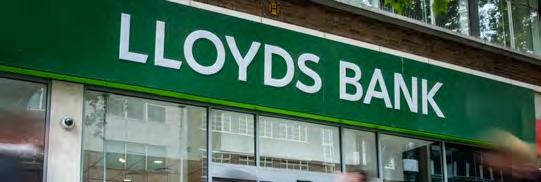

Is the UK’s biggest lender a smart investment right now?
As this is the last instalment in our five step stock analysis series (and we would encourage you to go back and read parts one, two and three, we’ve decided to do something a bit different and examine a bank. This means using different measures of profitability, returns and valuation.
To analyse a bank, you need to understand what it does, how it uses its balance sheet to make money and the quality of its assets.
While this may sound a bit daunting, the good news is most banks do the same thing so once you have looked at one the chances are you can transfer those skills to looking at others and start making comparisons.
STEP ONE: NET INTEREST MARGIN
At its core, banking is quite simple: you borrow money from depositors at one rate on a shortterm basis and lend it out at a higher rate on a long-term basis.
By charging more on loans than you pay on deposits, you make a spread known as a net interest margin.
The size of the net interest margin is determined by several things, including background interest rates, the bank’s brand power and its ability to attract depositors and borrowers, and the level of competition.
Feature: Analysing Lloyds banking 32 | SHARES | 24 August 2023
Net interest margin 1.0 2.0 3.0 4.0 5.0% 1Q18 2Q18 3Q18 4Q18 1Q19 2Q19 3Q19 4Q19 1Q20 2Q20 3Q20 4Q20 1Q21 2Q21 3Q21 4Q21 1Q22 2Q22 3Q22 4Q22 1Q23 2Q23 Net interest margin UK Base Rate
Chart:
Shares magazine•Source: Lloyds Banking, Bank of England. Note: Base rate prevailing at the end of each quarter
Using Lloyds Banking (LLOY) in our analysis is helpful because it is a pure ‘commercial’ bank, meaning it sticks to loans and deposits, unlike its rivals Barclays (BARC), HSBC (HSBA) and NatWest (NWG) which all have an investment banking business and are therefore known as ‘universal’ banks.
STEP TWO: LOOKING AT BAD DEBTS
Another unavoidable consequence of interest rates rising so quickly is firms which borrowed heavily when money was cheap are finding themselves in difficulty when it comes to paying interest on their loans or finding new sources of finance.
Bad loan ratio and provisions
Over much of the last decade, following the fallout from the great financial crisis and during the Covid-19 pandemic, global interest rates were so low that banks everywhere struggled to make much of a margin on their lending.
It was widely assumed that once economic growth picked up and interest rates started to rise, the banks would be able to make hay by boosting their loan books and increasing their net interest margins.
As it turns out, that window of opportunity seems to have been much smaller than analysts and investors thought, with Lloyds only being able to increase its net interest margin from an average of around 2.9% before the pandemic to 3.2% at best so far this year.
Nor is Lloyds alone – rivals Barclays and NatWest posted similar net interest margins in the first half, missing market expectations, and Barclays hinted at a weaker second half to come.




On the one hand, high interest rates have dampened demand for credit, while on the other depositors have moved money out of non-interestbearing accounts in search of better rates on their savings meaning banks have had to compete aggressively for deposits to fund their lending.
With interest rates having jumped from 1.75% a year ago to 5.25% at the time of writing, and analysts forecasting a peak of 6% for this cycle, we suspect loan demand will be choked off further while deposit rates will have to stay high to attract customers, so the idea that banks are big winners in this environment seems to be a fallacy.
Feature: Analysing Lloyds banking 24 August 2023 | SHARES | 33
2Q23 0.36% 419 1Q23 0.22% 243 4Q22 0.38% 465 3Q22 0.57% 668 2Q22 0.17% 200 1Q22 0.16% 177 4Q21 −0.41% −467 3Q21 −0.07% −84 2Q21 −0.30% −333 1Q21 −0.29% −323 4Q20 0.11% 128 3Q20 0.27% 301 2Q20 2.16% 2,388 1Q20 1.30% 1,430 4Q19 0.30% 341 3Q19 0.33% 371 2Q19 0.27% 304 1Q19 0.25% 275 4Q18 0.18% 197 3Q18 0.25% 284 2Q18 0.18% 198 1Q18 0.23% 258 Period Bad loan ratio % Bad loan provisions £m
Table: Shares magazine•Source: Lloyds Banking. Note: Minus means a write-back of previous provisions
The latest figures from the UK Insolvency Service show the number of compulsory liquidations in July 2023 was 81% higher than a year ago, due to a combination of higher rates and the withdrawal of government support measures in response to the pandemic, while the number of CVAs (company voluntary arrangements) was also higher.
As a bank, the trick is to know your customers so you don’t lend money to people who aren’t likely to pay it back in the first place, a process which nowadays is done by clever risk-management software rather than by the branch manager as it was in the past.
Staying on top of what the industry quaintly refers to as ‘non-performing’ loans means having to put aside provisions for those that are either ‘bad’, meaning they need to be written off in their entirety now, or ‘doubtful’, meaning full repayment is questionable and may not happen, making it necessary to put aside a contingency today.
Sometimes, banks put together packages of non-performing loans and sell them to non-bank finance firms like hedge funds just to try to recoup least some of the money they are owed, and the hedge funds then use a collection agency to chase up the repayment, but clearly the lower the level of bad loans to begin with the better the bank’s risk management tools.
Lloyds is the UK’s largest lender thanks to its entrenched position in the mortgage market, courtesy of its ownership of the Halifax building society, and mortgages are by their nature long-term but more importantly backed by property assets.
Therefore, in a worst-case scenario, if a homeowner couldn’t pay their mortgage the bank could take possession of the house, although more likely it would reach an agreement with the borrower which allowed them to pay what they can while still keeping a roof over their heads.

Lloyds’ bad loan ratio – or what it calls its asset quality ratio – is very low for now, but with the full effect of the past year’s sharp rise in interest rates still to feed through it is quite possible this ratio will increase and the bank will have to set aside much more by way of provisions.
STEP THREE: MEASURING RETURNS
Whereas with other companies in our analysis like Greggs (GRG) and Unilever (ULVR) we measured their return on capital employed, with banks the most frequently used yardstick is return on tangible equity or RoTe.
Simply put, RoTe is profits after tax divided by the bank’s common equity which excludes any
Return on tangible equity
Feature: Analysing Lloyds banking 34 | SHARES | 24 August 2023
2Q23 13.6% 12.0% 1Q23 19.1% 11.8% 4Q22 11.0% 9.7% 3Q22 4.2% 7.7% 2Q22 13.0% 10.3% 1Q22 10.7% 13.1% 4Q21 2.9% 13.9% 3Q21 14.5% 14.7% 2Q21 24.4% 12.6% 1Q21 13.9% 4.9% 4Q20 5.9% 2.4% 3Q20 6.0% 3.7% 2Q20 −6.1% 1.5% 1Q20 3.7% 5.6% 4Q19 11.0% 7.8% 3Q19 −2.8% 7.0% 2Q19 10.5% 11.4% 1Q19 12.5% 11.8% 4Q18 7.8% 11.7% 3Q18 14.8% 12.0% 2Q18 11.9% 10.5% 1Q18 12.3% 9.7% Period RoTe Trailing 12m RoTe
Table: Shares magazine•Source: Lloyds Banking
preference shares.
In a recent edition of Financier Worldwide Magazine, Shaun Taylor, chief financial officer for the Americas at Standard Chartered (STAN), called RoTe ‘the most important metric in the banking sector’ and argued banks should adopt it internally.
‘Everyone has a role to play in improving RoTE and by enabling everyone in a financial institution to understand its importance, it becomes the norm to think about it in everyday decision making, regardless of geography, sector or product. It can be applied to big strategic decisions like entering and exiting markets, just as it can be applied to smaller ones such as infrastructure spend and headcount.
‘RoTE makes it possible to align everyone to thinking commercially, focusing on how they can help make better or faster decisions with respect to uplifting their bank’s RoTE, and to look at it from a return perspective with one metric, as opposed to a cost perspective with multiple metrics. Aligning all stakeholders – internal and external – with the mindset of optimising for RoTE is important to deliver the best financial outcomes for any bank.’
As a rule, investors expect banks to generate a RoTe more than 10% and there is a strong correlation between returns and share price, with banks that have a higher return generally having higher share prices.
Here it must be said Lloyds doesn’t fare very well, with RoTe seeming to swing around wildly as net profits wax and wane – even smoothing the returns over 12 months doesn’t disguise the variations although it does suggest underlying returns are over 10% in ‘normal’ times.
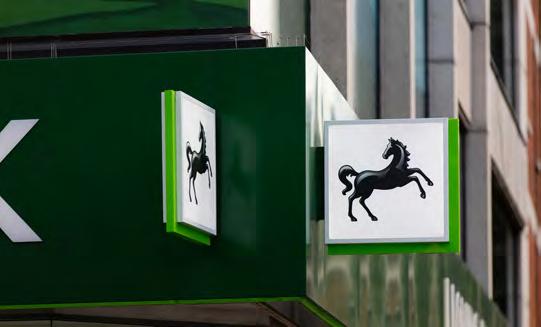
STEP FOUR: KEEPING TABS ON COSTS
As Standard Chartered’s Taylor suggests, using RoTe as an internal benchmark and working to optimise returns benefits all stakeholders and one obvious way to do that is to take costs out of the business. Besides the cost of attracting deposits, which is largely set by the market, banks have sizeable cost bases in terms of their physical operations so running a tight ship is essential
Cost-to-income ratio
Feature: Analysing Lloyds banking 24 August 2023 | SHARES | 35
2Q23 50.6% 49.9% 1Q23 47.1% 49.8% 4Q22 53.7% 51.1% 3Q22 48.1% 54.7% 2Q22 50.3% 54.7% 1Q22 52.3% 56.5% 4Q21 68.0% 56.5% 3Q21 48.3% 54.5% 2Q21 57.4% 56.6% 1Q21 52.3% 56.1% 4Q20 59.9% 55.4% 3Q20 56.9% 54.2% 2Q20 55.2% 51.9% 1Q20 49.7% 49.9% 4Q19 55.1% 48.6% 3Q19 47.6% 48.6% 2Q19 47.1% 48.5% 1Q19 44.7% 48.6% 4Q18 54.9% 49.4% 3Q18 47.1% 47.3% 2Q18 47.7% 47.2% 1Q18 47.8% 47.0% Period Ratio Trailing 12m Ratio
Table: Shares magazine•Source: Lloyds Banking
Rather as managers like Terry Smith always look at gross margins to see how much profit a business makes for every pound of sales it generates; with banks we can look at their cost-to-income ratio.

Whereas with gross margins it’s a case of the higher the better, with cost-to-income we want to see as low a number as possible and ideally something below 50%.
In the case of Lloyds, day-to-day operating costs aren’t that excessive and pre-pandemic the bank largely kept its cost-to-income ratio below 50%.
Post-pandemic it has been a different matter, with the bank having to take charges for ‘remediations’, i.e., fines from the regulator for misconduct, restructuring costs and investments in new businesses, but it looks as though the trend is downward once more.

STEP FIVE: HOW TO VALUE A BANK
As should be obvious by now, banks are a different beast so rather than valuing them on price-toearnings or EV (enterprise value) to EBITDA (earnings before interest, taxes, depreciation and amortisation) we look at price to tangible net assets or what is known as ‘book value’.
In the case of Lloyds, tangible net asset value per share remained remarkably resilient during the pandemic, but in the last 12 months it has been on a downward path as rising interest rates have impacted the bank’s cash-flow hedge reserve.
Price to book value
It is possible that once base rates stabilise –whether that is above or below 6% we don’t know – tangible net assets will recover, but as it stands it doesn’t look as though potential investors are getting great value for their money.
While the bank has said it wants to generate sustainable RoTe above 10%, and it has a handle on costs, if the economy turns down sharply as a result
of further rate hikes the risks to the balance sheet and earnings will increase.
Paying roughly book value at this point in the cycle, when more of the bank’s assets will likely turn bad soon, doesn’t seem like a great investment to us in terms of risk versus reward.
By Ian Conway Companies Editor
Feature: Analysing Lloyds banking 36 | SHARES | 24 August 2023
2Q23 44.6745.7 0.98 1Q23 51.9649.6 1.05 4Q22 46.1346.5 0.99 3Q22 42.7044.5 0.96 2Q22 45.1351.4 0.88 1Q22 45.7853.7 0.85 4Q21 47.6957.5 0.83 3Q21 44.0256.6 0.78 2Q21 49.7855.6 0.90 1Q21 39.0152.4 0.74 4Q20 38.2752.3 0.73 3Q20 26.9452.2 0.52 2Q20 30.8651.6 0.60 1Q20 49.5457.4 0.86 4Q19 59.9450.8 1.18 3Q19 50.3252.0 0.97 2Q19 57.0553.0 1.08 1Q19 62.8553.4 1.18 4Q18 55.9553.0 1.06 3Q18 59.6251.3 1.16 2Q18 63.3552.1 1.22 1Q18 68.3252.3 1.31 Period Share price (p) TNAV per share (p) Price/book value
Table: Shares magazine•Source: Lloyds Banking, Refinitiv. Note: TNAV = tangible net asset value
CENTRALNIC GROUP (CNIC)


Michael Riedl CEO and Billy Green CFO
A leading UK-headquartered global internet solutions company that operates in two highly attractive markets: high-growth digital advertising (Online Marketing segment) and domain name management solutions (Online Presence segment).
FORESIGHT SUSTAINABLE REAL ESTATE SECURITY (REF)

Speaker: TBC
An opportunity for investors to access the income and dependable returns associated with real estate investing alongside the liquidity provided by the public markets. A liquid route to a sustainable, diversified real estate portfolio.
Sponsored by WEBINAR Join Shares in our next Spotlight Investor Evening webinar on Tuesay 05 September 2023 at 18:00 Click here to register for this free event www.sharesmagazine.co.uk/events Register to hear the following companies presenting their plans for 2023
Why Premier Foods’ growth prospects are exceedingly good
THEBIG INTERVIEW
Shares discusses brands, balance sheet rehabilitation and overseas growth spice with finance director Duncan Leggett
One of Shares 2023 Tips of The Year, Mr. Kipling, Bisto, Sharwood’s and Ambrosia brands owner Premier Foods’ (PFD) stock is up 11.5% year-to-date, extending five-year gains to nigh-on 190%.

Ravenous investor appetite for the shares in recent years reflects the considerable progress made in reducing debt and resolving its pension
PREMIER FOODS (PFD)

Share price: 121.8p
Market cap: £1.07 billion



Listing: FTSE 250






issues, as well as the consistent growth from its brands and cycle of forecast upgrades served up under the stewardship of CEO Alex Whitehouse, not to mention a welcome return to the dividend list after a lengthy absence.

The FTSE 250 food maker has repaid our faith with a positive return this year thanks to strong full year results (18 May) showing trading profit growth of 11.5%, ahead of upgraded guidance. Premier Foods followed this up with a robust first quarter trading update (20 July), which revealed a 21.1% rise in group sales with core brands like Batchelors, Bisto and Oxo taking further market share as consumers cook more at home to keep costs down.
Significantly, Premier Foods also said it believed recent high input cost inflation was ‘past its peak’, meaning it had no need to raise prices again this year. And with the quarter’s strong sales momentum set to continue, full year trading profits should be at the top end of market expectations. Broker Numis recently argued Premier’s
Feature: Premier Foods 38 | SHARES | 24 August 2023
combination of ‘strong brands, well defined domestic and international growth opportunities and a proven track record in innovation and execution should sustain this growth momentum’. We believe the grudging prospective price-toearnings (PE) ratio of sub-10 times represents excellent value in this context.
RESONANCE AND RELEVANCE
Premier Foods is one of Britain’s biggest food producers, employing 4,000-plus people operating from 15 sites across the country and supplying major retailers and foodservice customers with iconic brands found in millions of homes every day. So Shares jumped at the opportunity to discuss the business with its busy finance director Duncan Leggett.
He says Premier Foods’ competitive strengths include its ‘great portfolio of established and wellloved brands that have got a lot of resonance and relevance, particularly with the UK consumer, but increasingly overseas.

‘We’ve been employing what we refer to as our branded growth model - making sure we invest behind our strong brands and in emotionally engaging advertising with the consumer, and that we execute brilliantly with our retail partners.’ Being a branded fast moving consumer goods (FMCG) company has been the ‘heart of our success over the years, certainly from a commercial perspective,’ he explains.
REMOVING THE OVERHANG
‘There’s a been a lot of history around Premier Foods and its levels of debt and pension fund

Mr. Kipling market share in Australia
Mr. Kipling market share in Australia
Mr. Kipling market share in Australia

obligations,’ concedes Leggett when quizzed on the balance sheet. But he stresses leverage has been brought under control, with Premier Foods paying debt down increasingly each year over the last few years. ‘And we did a transformational refinancing in 2021 which significantly reduced our cost of debt and fixed it for quite a few more years as well,’ he points out.
In March 2020, Premier Foods entered a merger agreement for its two pension schemes, which are now managed by the same trustees. The current NPV (net present value) of deficit payments is around £125 million, roughly half what it was last year, and management are targeting full resolution of the pension deficit within three years. Not only would this boost the company’s free cash flow generation, but it would also remove an overhang for the equity story.
Feature: Premier Foods 24 August 2023 | SHARES | 39
FY 17 2.5% FY 18 3.1% FY 19 4.1% FY 20 6.8% FY 21 8.6% FY 22 8.8% FY 23 10.2% Table: Shares magazine • Source: Numis, Premier Foods
FY 17 2.5% FY 18 3.1% FY 19 4.1% FY 20 6.8% FY 21 8.6% FY 22 8.8% FY 23 10.2% Table: Shares magazine • Source: Numis, Premier Foods
FY 17 2.5% FY 18 3.1% FY 19 4.1% FY 20 6.8% FY 21 8.6% FY 22 8.8% FY 23 10.2% Table: Shares magazine • Source: Numis, Premier Foods Forecasts
Premier Foods 2023 (A) 137.2 12.6 261 9.7 2024 (F) 143.5 12.2 213 10.0 2025 (F) 152.6 13.0 143 9.4 2026 (F) 159.2 13.6 66 9.0 Year to March Pre-tax profit (£m) Earnings per share (p) Net debt (£m) Price to earnings ratio Table: Shares magazine • Source: Numis Securities
for
‘We think about three years is a reasonable timeframe to effectively solve Premier’s longstanding pension challenge,’ continues Leggett. ‘And if we can get £40 million of free cash that we can invest behind the business, that’s pretty exciting.’ As for Numis, it thinks that ‘a final resolution of the pension issues could trigger a further re-rating in the shares’.
BROAD-BASED GROWTH
Numis notes that over the last three years, Premier Foods has achieved 5.3% average annual growth from its branded UK business. ‘The underlying trend towards increased athome meal consumption has been positive but the company has also successfully navigated a number of challenges including mitigating substantial cost pressures and increased competition from private label’, says the broker.
Leggett informs Shares that Premier Foods’ model is to have ‘an NPD (new product development) pipeline behind every brand and we invest, albeit proportionately, behind every brand to generate growth.
‘We’ve got an innovation pipeline from everything from Mr Kipling, one of our biggest brands, down to Angel Delight, which is one of our smaller brands.’

The company’s growth has been reassuringly broad-based over the last few years, stresses Leggett. ‘You can see from last year’s results that brands like Batchelors grew over 20%, proving very relevant with the environment we’re in, and we continue to see market share gains pretty much across our grocery category and brands.’
Premier Foods’ balance sheet rehabilitation has allowed the company to identify and launch several new product innovations by taking existing brands into adjacent categories. The most successful example to date has been the launch of Ambrosia porridge pots, which target the breakfast and snacking
BRANDS WITH RICH HISTORY
Premier Foods’ portfolio of household brands has a long history with the oldest, Bird’s custard powder, dating back to 1837, the start of Queen Victoria’s reign. The genesis of today’s Premier Foods business was the creation of Hillsdown Holdings in 1975. The business listed on the London Stock Exchange in 2004.

The Grocery division is Premier Foods’ largest, accounting for 74% of revenue in the year to March 2023, with Sweet Treats accounting for 26%. ‘Revenue is principally generated from its Branded activities which represented 87% of revenues last year,’ explains Numis. ‘At a divisional level the split between Branded and Non-Branded is broadly consistent with brands accounting for 85% of Grocery sales and 80% of Sweet Treats.’
category, while other examples include ice cream under the Ambrosia and Mr. Kipling brands as well as Oxo marinades.

THE BEST RESTAURANT IN TOWN
‘Clearly, this is a really difficult economic environment,’ says Leggett. ‘We try and stop the inflation happening in the first place through hedging and procurement strategies. We offset everything we can through our efficiency programmes, particularly in our supply chain and in our factories.’ And despite raising prices as a last resort to offset inflationary pressures, Premier Foods served up ‘pretty good growth last year and again into quarter one this year, our brands are still performing really well’.
Premier Foods created the ‘Best Restaurant in Town’ marketing campaign
Feature: Premier Foods 40 | SHARES | 24 August 2023
aimed at getting people to recreate affordable restaurant style meals at home. ‘One of the roles that we’re trying to play is to help inspire consumers,’ insists Leggett. ‘Because our products are great components of affordable meals and the Best Restaurant in Town is trying to equip consumers with a few more ideas about how to use our products to create meals for £1.25 a portion or whatever it may be.’
RECIPE FOR OVERSEAS GROWTH
Leggett says international is ‘absolutely one of the key pillars of our strategy and we see three brands as having global potential’. These are Mr Kipling, cooking sauce brand Sharwood’s and also, The Spice Tailor, the Asian meal kit business acquired for £43.8 million last year in a deal marking Premier Foods’ first acquisition in 15 years.
Premier Foods’ international footprint is now mainly based in Ireland and Australia and ‘we’ve got a bit in Europe and in North America,’ says Leggett. ‘Mr. Kipling is going great guns in Australia, where market share is at an all-time record high. We’ve really established the market leader within branded cake from a relatively standing start over the last six or seven years,’ he explains.

Admittedly, America has proven to be a graveyard for many British brands down the years, but Mr Kipling was recently launched in the US through a successful test in Target (TGT:NYSE) stores, and the brand’s distribution has expanded across the pond since.
As for The Spice Tailor, Leggett insists the brand has a ‘great repeat rate’.
‘Try it and you are pretty likely to want to buy it again. Spice Tailor was growing at 20% before we bought it and last year, we increased the growth rate to 25%. We’ve gained distribution in the UK, Ireland and North America already, so it is all very much going according to plan.’
ACQUISITIONS BACK ON THE MENU
Following its success with The Spice Tailor, Premier Foods plans to undertake further M&A and Numis reckons the company has roughly £200 million of potential firepower for acquisitions.
‘We are absolutely on the lookout for something else that we could apply the model to,’ says
Revenue by customer in 2023 financial year
Revenue by customer in 2023 financial year
Revenue by customer in 2023 financial year
Leggett. though he stresses management are selective both in terms of the brands they target and the price they are willing to pay in the interests of maintaining discipline. ‘But we definitely see potential for bolt-on deals to help step-change our growth rate,’ he adds.
With consumers increasingly seeking to improve the nutritional content of their diets, manufacturers are focusing on removing calories, sugar, salt and fat from their products and Premier Foods is playing its part. Examples include its range of Mr. Kipling ‘Deliciously Good’ cakes and pies, classified as non-HFSS (non-high in fat, salt and sugar). ‘We completely buy in and work constructively with government and regulation bodies on what they choose,’ says Leggett. ‘Part of our strategy is to offer healthy options and healthy choices across all of our portfolio, we very much believe in offering the consumer choice and healthier options.’
By James Crux Funds and Investment Trusts Editor

Feature: Premier Foods 24 August 2023 | SHARES | 41
Tesco 24% Sainsbury's 14% ASDA 11% Morrisons 10% Hard Discounters 7% Food Service 7% High Street Discounters 6% CO-OP 5% Iceland 5% Waitrose 3% Other 8% Table: Shares magazine • Source: Numis Securities, Premier Foods
Tesco 24% Sainsbury's 14% ASDA 11% Morrisons 10% Hard Discounters 7% Food Service 7% High Street Discounters 6% CO-OP 5% Iceland 5% Waitrose 3% Other 8% Table: Shares magazine • Source: Numis Securities, Premier Foods
Tesco 24% Sainsbury's 14% ASDA 11% Morrisons 10% Hard Discounters 7% Food Service 7% High Street Discounters 6% CO-OP 5% Iceland 5% Waitrose 3% Other 8% Table: Shares magazine • Source: Numis Securities, Premier Foods
A balanced approach to investing in the UK market
The UK stock market comprises a wide range of businesses from established global giants to ambitious small and mid-sized companies. Investing across the spectrum offers the potential for both income and capital growth.
The last few years have been challenging for many UK companies, which have faced a global pandemic followed by an inflation shock. But despite these difficulties, many UK companies have proved resilient or even thrived, and have continued to offer solid income to investors. With the pandemic now fading into history and the economy adjusting to a new normal, there is also the prospect of capital growth.
The Lowland Investment Company has an unwavering focus on UK business with more than 95% of its portfolio invested in UK companies. The Trust aims to provide investors with a higherthan-average return with growth of both capital and income over the medium and long-term. However, the key to its strategy, is diversification, not only in terms of industry sectors, but also links to the UK and global economy, and crucially their size and growth potential.

Large cap for income
A diversified portfolio is what allows Lowland to
chart a smoother path through the ups and downs of the economic cycle. In tough times, large companies – particularly in sectors such as finance energy and consumer products – are resilient and may even thrive in a high interest rate and high inflation environment. In periods of confidence, mid-sized and smaller groups – many of them innovators in their field – attract investment, expand, and increase in value.
Lowland draws its portfolio from across the UK listed market, from FTSE 100 blue chip giants to mid-cap and small-cap companies that have the potential to grow and become the big businesses of the future. This blend offers investors the potential for income and growth across the economic cycle.
UK-based global businesses provide a solid foundation for income and up to 50% of Lowland’s investments are in FTSE 100 companies. This includes household names such as Shell, BP, HSBC, and National Grid. While the UK economy has
Marketing communication. Not for onward distribution. Not for distribution in European Union member countries. The value of an investment and the income from it can fall as well as rise and you may not get back the amount originally invested. Past performance does not predict future returns

THIS IS AN ADVERTISING PROMOTION
faced many challenges in recent years, these large companies have been the stabilizing factor on Lowland’s portfolio and have continued to provide a steady and reliable income. This bedrock of dividend-paying companies has allowed Lowland to maintain a progressive dividend policy with dividends rising every quarter for the last 10 years. In 2022, investors in Lowland received an impressive yield of 5.8%.i
Mid and small cap for growth potential
As experienced investors know, achieving sustained capital growth is a longer-term game. The recent difficulties faced by the UK economy have held back growth prospects for many businesses, but as Covid fades into history and the economy adjusts to the new normal of higher inflation and interest rates, there are opportunities to be found in the mid- and small-cap sectors of the UK market.
In fact, the prospects for mid and smaller companies are better now than they have been for some time. UK equities look undervalued both on fundamental terms and compared to other
developed markets. This is particularly true for UK mid-and small cap stocks which offer investors exposure to faster growing companies at an earlier stage of their lifecycle, and therefore the potential for a longer pathway of earnings growth ahead of them.

Lowland’s investment in mid- and smaller-cap companies is diverse and aimed at identifying the best prospects for capital growth. This includes companies such as Serica Energy and Ilika that are innovating within the energy sector.
Striking the balance
It has a been a difficult few years for UK plc, but despite this backdrop Lowland Investment Company has succeeded in delivering income to its investors. And with a portfolio that combines big dividend paying groups with fast growing midand small cap companies, it provides investors with complete exposure to the UK market. For investors looking for consistent and stable income and the potential to share in long-term growth of the UK businesses, Lowland Investment Company is worth a look.
iSource: Lowland Investment Company Annual Report 2022

THIS IS AN ADVERTISING PROMOTION
30/6/2022 - 30/6/2023 4.5 5.5 30/6/2021 - 30/6/2022 −9.4 −5.4 30/6/2020 - 30/6/2021 44.6 41.9 30/6/2019 – 30/6/2020 −24.2 −23.1 30/6/2018 – 30/6/2019 −6.9 −9.6 Discrete year performance (%) Share price (total return) NAV (total return)
These are the views of the author at the time of publication and may differ from the views of other individuals/teams at Janus Henderson Investors. References made to individual securities do not constitute a recommendation to buy, sell or hold any security, investment strategy or market sector, and should not be assumed to be profitable. Janus Henderson Investors, its affiliated advisor, or its employees, may have a position in the securities mentioned.
Past performance does not predict future returns. The value of an investment and the income from it can fall as well as rise and you may not get back the amount originally invested.
The information in this article does not qualify as an investment recommendation.
Janus Henderson and Knowledge Shared are trademarks of Janus Henderson Group plc or one of its subsidiaries. © Janus Henderson Group plc.
GC-0123-121490 01-31-24 TL
IMPORTANT INFORMATION
References made to individual securities do not constitute a recommendation to buy, sell or hold any security, investment strategy or market sector, and should not be assumed to be profitable. Janus Henderson Investors, its affiliated advisor, or its employees, may have a position in the securities mentioned.
Not for onward distribution. Before investing in an investment trust referred to in this document, you should satisfy yourself as to its suitability and the risks involved, you may wish to consult a financial adviser. This is a marketing communication. Please refer to the AIFMD Disclosure document and Annual Report of the AIF before making any final investment decisions. Past performance does not predict future returns. The value of an investment and the income from it can fall as well as rise and you may not get back the amount originally invested. Tax assumptions and reliefs depend upon an investor’s particular circumstances and may change if those circumstances or the law change. Nothing in this document is intended to or should be construed as advice. This document is not a recommendation to sell or purchase any investment. It does not form part of any contract for the sale or purchase of any investment. We may record telephone calls for our mutual protection, to improve customer service and for regulatory record keeping purposes.
Issued in the UK by Janus Henderson Investors. Janus Henderson Investors is the name under which investment products and services are provided by
Janus Henderson Investors International Limited (reg no. 3594615), Janus Henderson Investors UK Limited (reg. no. 906355), Janus Henderson Fund Management UK Limited (reg. no. 2678531), (each registered in England and Wales at 201 Bishopsgate, London EC2M 3AE and regulated by the Financial Conduct Authority) and Janus Henderson Investors Europe S.A. (reg no. B22848 at 2 Rue de Bitbourg, L-1273, Luxembourg and regulated by the Commission de Surveillance du Secteur Financier).

Janus Henderson and Knowledge Shared are trademarks of Janus Henderson Group plc or one of its subsidiaries. © Janus Henderson Group plc.
These are the views of the author at the time of publication and may differ from the views of other individuals/teams at Janus Henderson Investors.
References made to individual securities do not constitute a recommendation to buy, sell or hold any security, investment strategy or market sector, and should not be assumed to be profitable. Janus Henderson Investors, its affiliated advisor, or its employees, may have a position in the securities mentioned.
Past performance does not predict future returns. The value of an investment and the income from it can fall as well as rise and you may not get back the amount originally invested.
The information in this article does not qualify as an investment recommendation.
THIS IS AN ADVERTISING PROMOTION
Is China about to face its Minsky moment as country’s property crisis intensifies?
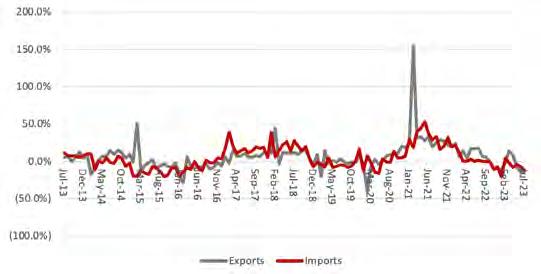
The world’s second largest economy looks to be teetering amid mounting economic woes
Upon finding James Bond crossing his path for a third time in quick succession, in Miami over cards, Kent for golf and then Geneva, Auric Goldfinger finally senses trouble and tells 007, ‘Mr Bond, they have a saying in Chicago: Once is happenstance. Twice is coincidence. The third time it is enemy action’.
Regardless of whether China sees its economic woes as selfinflicted or the efforts of third parties to undermine its prospects, there can be no denying that its troubles are currently coming in threes:
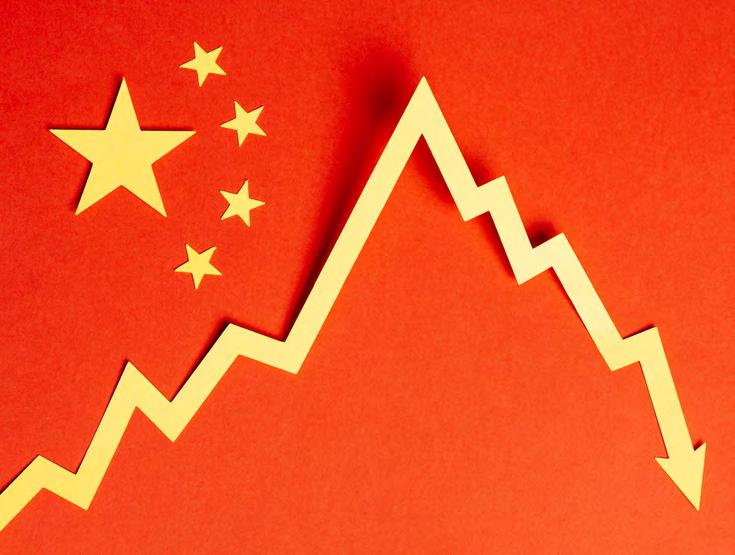
● Its largest residential property developer, Evergrande, is now filing for Chapter 15 bankruptcy protection in the USA, two years after it first missed scheduled interest payments on its huge foreign debt pile.
● Its second largest property developer, Country Garden, is now skipping coupon payments to its bondholders.
● Finance company Zhongrong, a so-called ‘trust’ specialist that invests savers’ pooled capital across China in a range of assets, has missed payments on maturing schemes to its product holders, be they corporations or wealthy individuals. The liquidity crunch here could in turn be the result of the Chinese residential property downturn as house prices fall, volumes dry up and property companies miss interest payment deadlines.
American and Western sanctions designed to restrict investment and the flow of intellectual

property as well as certain products, such as cutting-edge silicon chips and semiconductor production equipment, could be seen by China as enemy action. But none of this can be coincidence and it suggests there may be further trouble ahead.
MINSKY MOMENT
China is doing its best to keep the plates spinning, cutting both interest rates and the amount of capital that banks have to hold (thus boosting
Russ Mould: Insightful commentary on market issues 24 August 2023 | SHARES | 45
Source: Refinitiv data
Chinese global trade flows have sagged badly in 2023
their ability to lend) but some economists are arguing that the debt numbers mean China simply cannot grow at its current rate for too much longer. Some even argue that the country is facing its own Minsky Moment, as its economy reaches the third stage of the debt cycle outlined by economist Hyman Minsky in his 1993 paper The Financial Instability Hypothesis:
● Hedge finance, whereby a mix of cashflow and equity help borrowers to fund interest payments on debt and eventually pay off their liabilities.


● Speculative finance, where debtors have enough money to cover interest but cannot repay the original loan, which must be rolled over.
● Ponzi finance, where borrowers are unable to pay off the interest, let alone the principal debt and resort to asset sales to pay the bills.
Investors may think this sound a little apocalyptic, but it may help to explain why the Shanghai Composite index is going nowhere fast – and is no higher now than in was in early 2018, when stock market index constructors such as MSCI and FTSE Russell began to include onshore Chinese A-class shares, and not just Hong Kong-traded H shares, in their benchmarks.

The higher weighting given to Chinese equities

raised the possibility that a wall of money from passive index trackers would flood into the market and push prices higher. It may have done at first, but not for long, and there is a danger that falling prices and falling weightings prompt a similar reflex, only this time to prompt a wave of passive selling.
Beyond the narrow confines of equity markets in Shanghai and Hong Kong, China’s property pickle begs many begs the question of what it means, if anything, for the global economy and, in turn, investment portfolios. Three immediate topics spring to mind.
China’s economy looks likely to slow and state support will surely be required to limit the damage from a housing bubble that is bursting, with fiscal support a distinct possibility.
China runs a trade surplus, so it sells more than it buys. In this respect, the damage to global trade flows may not be quite as big as perhaps feared
However, a slower Chinese building market could logically hit raw material demand and thus potentially commodity prices, while a squeeze on consumers could have ripples in the international travel and luxury goods markets, especially in Asia.
How the Communist Party manages to support economic growth without piling up too much debt, or cutting interest rates to the point that the stock market becomes bubbly (as it did in 2007
Russ Mould: Insightful commentary on market issues 46 | SHARES | 24 August 2023
Source: Refinitiv data
The Chinese and Hong Kong stock markets have made little progress in the last five years
China is cutting interest rates …

… but the currency is weakening as a result
Source: Refinitiv data
and 2015) or the renminbi weakens (as it did in 2015-17 and 2019, leading to trade troubles with America) will be fascinating to watch. In the end if feels as if something will have to give – the currency or economic growth targets - especially if Minsky is right.

If there is any good news here, it may be that less demand for commodities and a weaker Chinese economy and currency take away some of the
Source: Refinitiv data
inflationary pressures that currently bedevil the West. Factory gate inflation in China, as measured by the producer price index, is already in negative territory, after all.
By Russ Mould Investment Director at AJ Bell





poDCAST poDCAST PODCAST

Listen to the AJ Bell Money & Markets podcast
Russ Mould: Insightful commentary on market issues
as Keep up to date on the important things that matter to investors
How AI could lead to a big transformation in the hotels industry and other sectors
Look behind the hype and there are concrete ways in which artificial intelligence can be applied
In all the market sound and fury around AI (artificial intelligence) in 2023 there seems to have been relatively little attention given to exactly what impact a rapid adoption of this technology might have.
The focus has largely been on the investment going into an AI arms race between the big technology firms, the development of generative AI for images and words and dystopian warnings suggesting we could see a repeat of the Skynet scenario in the Terminator films where the machines rise up against their human masters.
This hasn’t left much oxygen for the specifics around how different industries and sectors will be affected. However, that is beginning to change. One area where AI could lead transformative change with a global impact is in health care.
The UK recently allocated £13 million to investment in this area with hopes it can boost the speed and efficiency of research, enabling faster development of drugs as well as analysing test results and predicting the progression of different diseases.
We plan to look at the pharmaceutical industry’s efforts to incorporate AI into their projects and processes and the impact it might have on valuations and earnings in an article on the sector in the near future.
AI is being used for more everyday activities too and there was some interesting research published recently by Morgan Stanley on how it might transform the hotels sector.

The investment bank says AI can be a ‘game changer for the whole travel experience, from researching a trip to booking to engagement on property
to continued engagement post-stay’. Adding that: ‘From an owner/operator standpoint, AI should also power more personalised experiences and lower costs given opportunities across hotels’ systems for more tech integration.’
Morgan Stanley highlights some tangible examples of how the technology can be applied including tailoring their service to specific customers by suggesting rooms and trips based on preferences implied by previous bookings and activity on social media, offering AI-powered virtual tours of rooms, automated check-in and AI integration into room features such as lighting and temperature control.
Yet as Morgan Stanley notes adoption is relatively low (it estimates just 8% of accommodation providers are making use of AI-powered business tools like chatbots and dynamic pricing algorithms). It says: ‘More than two-thirds (66%) do not yet have any plans to use AI in how they run their businesses, creating the possibility of technological disparity and a corresponding competitive advantage/disadvantage.’
This divergence in competitive advantage could become evident in other sectors and investors should start taking a closer look at what businesses are doing to harness the opportunities provided by AI and deal with any competitive threats it might pose in financial results and annual and interim reports. Failure to address these issues could easily see firms getting left behind.

Editor’s View: Tom Sieber 48 | SHARES | 24 August 2023
This divergence in competitive advantage could become evident in other sectors and investors should start taking a closer look at what businesses are doing to harness the opportunities provided by AI”
WATCH RECENT PRESENTATIONS

Fulcrum Metals (FMET)
Ryan Mee, CEO
Fulcrum Metals (LON:FMET) is a multi-commodity explorer with a diverse portfolio of gold, base metal, and uranium projects positioned close to mineral rich prospective areas and producing or near producing assets in Canada, a world-class mining destination.
India Capital Growth Fund (IGC) Gaurav Narain, Co-Head of Equity




The India Capital Growth Fund (ICGF) is a closed ended Investment Company, listed on the main board of the London Stock Exchange. It follows a bottomup long-term investment approach focused on India’s small and midcap market with a concentrated portfolio of around 30 holdings. ICGF is managed by Ocean Dial, a single country focused asset management company investing directly into India.
Good Energy Group (GOOD)
Nigel Pocklington, CEO
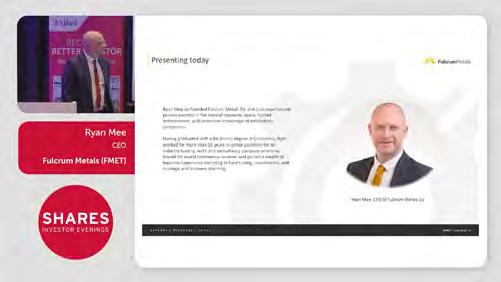
Good Energy Group (GOOD) is a supplier of 100% renewable power and an innovator in energy services. It has long term power purchase agreements with a community of 1,700 independent UK generators. Since it was founded 20 years ago, the company has been at the forefront of the charge towards a cleaner, distributed energy system.

Visit the Shares website for the latest company presentations, market commentary, fund manager interviews and explore our extensive video archive.
CLICK TO PLAY EACH VIDEO SPOTLIGHT WEBINAR www.sharesmagazine.co.uk/videos VIDEOS
The impact of rising prices and borrowing costs has had a big but uneven impact on personal finances
The headlines have been filled with news of sky-high inflation and the Bank of England’s subsequent interest rate rises. But we thought it would be handy to go through exactly why inflation is high, how interest rates are meant to curb it and whether it’s actually working.
WHY IS INFLATION HIGH?
In an ideal world inflation would hover around 2%, but in August 2021 it started rising sharply before hitting a peak of 11.1% in October 2022. Inflation is the rate at which prices are rising, based on an example basket of goods that the Office for National Statistics puts together. This virtual basket has a variety of items, from haircuts to flights abroad to a pint of milk.
Inflation rose after the pandemic, with much of it linked to the Covid-19 crisis. As countries around the world emerged from various lockdowns, the demand for goods and services rose. The higher the demand for an item, the higher prices will go.

At the same time, a lot of supply wasn’t there, creating scarcity, which pushes up prices further. Let’s take the car market as one example, there was shortage of chips for new cars, which meant fewer were available. That pushed up prices of both new and second-hand cars, which feeds into inflation figures.
Brexit also impacted the UK – although it’s trickier to measure the exact impact of this and separate it from the post-pandemic demand boom. But there is some data that shows it caused a worker shortage, further impacting that supply/ demand issue.
This was meant to be a short-term blip while companies and factories got back to full speed post-pandemic. But then the RussiaUkraine war broke out, which impacted several markets from wheat to oil to energy – creating another supply problem and pushing up prices again.
The fallout from a period of high inflation is that workers demand higher wages to help them keep pace with rising costs, but that in turn pushes up
Personal Finance: Inflation 50 | SHARES | 24 August 2023
Understand the basics on inflation and how interest rates help curb it
Bank of England Base Rate
CPI inflation
costs for businesses who then raise prices to pay for them – leading to more inflation.
WHY WILL INTEREST RATES REDUCE INFLATION?
The Bank of England is limited in what it can do to curb inflation – and its main tool is interest rates. The Bank wants people to stop spending so much money, so there is less demand for items and prices can stop rising by so much (or even fall).
If it hikes interest rates that pushes up the cost of borrowing, from credit cards to debt, which discourages people from borrowing money that they will then spend. For example, when borrowing is cheap you might buy a new sofa and put it on your credit card, but if that’s going to cost you a lot of money in interest you might decide to delay the purchase. At the same time, a higher base rate pushes up the interest rates on offer to savers, meaning they might be more inclined to save money in their bank account rather than splurge it on a new holiday or a new car.
The unfortunate side effect of this is that it will slow the economy – if fewer people are buying things that reduces growth in the economy, which can have the knock-on effect that businesses must cut costs and lay-off staff. In turn that means less chunky pay rises for staff, as there are more unemployed people willing to work, meaning businesses have their pick of staff and so don’t have to pay them more.
That’s all the theory, but there are lots of variables that impact how this works in practice – as we’ve seen in the current economy and
previously. If the Bank pushes rates too far it risks the economy falling into recession, but not far enough and it risks failing to curb inflation, which will then keep climbing.
WHAT IMPACT HAVE RATE RISES HAD ON OUR PERSONAL FINANCES
Both savings and mortgage rates have shot up –but the impact hasn’t been as direct as some might have assumed. Let’s take savings rates first, the top easy-access account has risen from 0.65% in August 2021 up to 4.8% today, according to Moneyfacts. The fixed rate market has seen a bigger increase, with a one-year fix going from 1.31% two years ago to 6.02% today.
But banks haven’t increased rates by as much as the Bank of England hoped. While top rates have risen a lot, the average savings account hasn’t seen anywhere near that increase. On top of that, there is £270 billion of savers’ money sitting in accounts earning no interest at all. At the same time inflation is still higher than cash savings rates, meaning that even if you’re earning the best rate out there your money is losing spending power in real terms, which is a detractor from saving. It means that the draw to save money rather than spend it isn’t as alluring as it might be.
On the other side mortgage rates have gone up sharply: the average two-year fix has gone from 2.52% in August 2021 up to 6.85% today, according to Moneyfacts. That will have a dramatic impact on people’s mortgage repayments, but there is a considerable lag on the impact of this.
Most homeowners are on fixed-rate mortgages,
Personal Finance: Inflation 24 August 2023 | SHARES | 51
19801990200020102020 0 5 10 15% Chart: Shares magazine•Source: Bank of England
2021 2022 2023 0 2 4 6 8 10% Chart: Shares magazine•Source: Office for National Statistics
UK average five-year fixed mortgage rate
which mean rising mortgage rates make zero difference to their finances until they come to remortgage. That means that there is a slow, rolling impact of rising rates, rather than a quick, sharp one. The Bank of England estimates that only around half of people with a mortgage have remortgaged since rates started to rise in December 2021 – and some of those won’t have seen a huge increase in rates if the base rate hadn’t risen considerably by their re-mortgage date.
ARE THERE SIGNS RATE RISES ARE WORKING?
Inflation has fallen from the end of last year to under 7% today, so at a base level inflation is falling. It’s still a country mile from the Bank’s 2% target, but it’s heading in the right direction. That said, so-called ‘core inflation’, which strips out a lot of the volatile prices, such as food, energy, alcohol, and tobacco, didn’t drop between June and July.
On top of that, people are still spending heavily on things like holidays, eating out, hotels and other socialising. If you’ve paid off your mortgage then you’re benefitting from higher savings rates and not impacted by the higher borrowing costs. On top of that, many people are still sitting on big
piles of cash savings from the pandemic, so they are more insulated from the cost-of-living price increases.
It’s these people that the Government and Bank of England wants to stop spending, so that inflation will fall. But it’s not easy to do that without punishing those who are already hurting because of rate rises and high inflation.
In its latest report the Bank itself acknowledged that more interest rate rises won’t have a huge impact on inflation. Its own projections show that inflation will fall to 1.5% in three years’ time if it raises rates to 6% and then trims them back to 4.5%. But it also forecasts that inflation will fall to 1.4% if interest rates just stay at the current 5.25%.
It also admitted that the impact of interest rate rises is waning. But that doesn’t mean they are done with hiking. Instead, the Bank said it will ‘monitor closely’ any signs that inflation has become persistent and also the path of wage growth and will act if ‘there were to be evidence of more persistent pressures’.
By Laura Suter AJ Bell Head of Personal Finance

Personal Finance: Inflation 52 | SHARES | 24 August 2023
Apr 2019 JulOctJan 2020 AprJulOctJan 2021 AprJulOctJan 2022 AprJulOctJan 2023 AprJul 0 1 2 3 4 5%
For loan to value of 75% Chart: Shares magazine•Source: Refinitiv, Bank of England
WHO WE ARE
EDITOR: Daniel Coatsworth @Dan_Coatsworth
DEPUTY EDITOR: Tom Sieber @SharesMagTom
NEWS EDITOR: Steven Frazer @SharesMagSteve
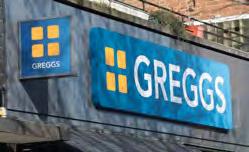
FUNDS AND INVESTMENT
TRUSTS EDITOR: James Crux @SharesMagJames
EDUCATION EDITOR: Martin Gamble @Chilligg
COMPANIES EDITOR: Ian Conway @SharesMagIan







INVESTMENT WRITER: Sabuhi Gard @sharesmagsabuhi

CONTRIBUTORS:
Danni Hewson
Laith Khalaf

Russ Mould
Tom Selby
Laura Suter
All Shares material is copyright. Reproduction in whole or part is not permitted without written permission from the editor.
Shares publishes information and ideas which are of interest to investors. It does not provide advice in relation to investments or any other financial matters. Comments published in Shares must not be relied upon by readers when they make their investment decisions. Investors who require advice should consult a properly qualified independent adviser. Shares, its staff and AJ Bell Media Limited do not, under any circumstances, accept liability for losses suffered by readers as a result of their investment decisions.
Members of staff of Shares may hold shares in companies mentioned in the magazine. This could create a conflict of interests. Where such a conflict exists it will be disclosed. Shares adheres to a strict code of conduct for reporters, as set out below.
1. In keeping with the existing practice, reporters who intend to write about any securities, derivatives or positions with spread betting organisations that they have an interest in should first clear their writing with the editor. If the editor agrees that the



reporter can write about the interest, it should be disclosed to readers at the end of the story. Holdings by third parties including families, trusts, selfselect pension funds, self select ISAs and PEPs and nominee accounts are included in such interests.
2. Reporters will inform the editor on any occasion that they transact shares, derivatives or spread betting positions. This will overcome situations when the interests they are considering might conflict with reports by other writers in the magazine. This notification should be confirmed by e-mail.
3. Reporters are required to hold a full personal interest register. The whereabouts of this register should be revealed to the editor.
4. A reporter should not have made a transaction of shares, derivatives or spread betting positions for 30 days before the publication of an article that mentions such interest. Reporters who have an interest in a company they have written about should not transact the shares within 30 days after the on-sale date of the magazine.

Index 24 August 2023 | SHARES | 53 Investment Trusts RIT Capital 16 Scottish Mortgage16 Shares magazine is published weekly every Thursday (50 times per year) by AJ Bell Media Limited, 49 Southwark Bridge Road, London, SE1 9HH. Company Registration No: 3733852.
DISCLAIMER ADVERTISING Senior Sales Executive Nick Frankland 020 7378 4592 nick.frankland@sharesmagazine.co.uk Main Market Anglo American 26 AstraZeneca 26 Bank of Georgia 9 Barclays 9, 33 BP 26 British American Tobacco 26 Diageo 26 Greggs 34 HSBC 26, 33 Lloyds Banking 33 NatWest 9, 33 PPHE Hotel Group10 Premier Foods 38 Reckitt Benckiser14, 26 Rio Tinto 26 Shell 26 Standard Chartered 35 Target 41 AIM Begbies Traynor 13 Dalata Hotel 10 Everyman Media 9 FRP Advisory 13 Overseas shares Alibaba 29 Alphabet 23 Amazon 21 Apple 17, 21 Berkshire Hathaway23 BYD 8 Coca-Cola 23 Colgate-Palmolive23 Faraday 8 Fast Retailing 28 Ford 8 General Motors 8 Intel 7 iShares Core MSCI Japan 28 JP Morgan Chase22 Keurig Dr Pepper15 L'Oreal 14 LVMH 14 Meta 17, 24 Microsoft 14, 21 Nestle 14, 22 Nio 8 Novo-Nordisk 22 Nvidia 6, 17, 23 PepsiCo 25 Pfizer 23 Procter & Gamble14, 23 Salesforce 11 Softbank 28 Taiwan Semiconductor Manufacturing Company 7 Tencent 29 Tesla 8, 17, 24 Unilever 14 UnitedHealth 22 VinFast 8 Visa 23 Wolters Kluwer 14 Wuling 8 Xpeng 8 Funds TB Evenlode Global Income 14 TB Evenlode Income14 ETFs Franklin FTSE China29 HSBC Hang Seng Tech29 iShares Core FTSE 10026 iShares Core S&P 50023 iShares Dow Jones Industrial Average 25 iShares Core MSCI World UCITS ETF 22 Lyxor Core STOXX Europe 600 27 Lyxor FTSE 100 ETF26 Vanguard FTSE 10026 Xtrackers Nasdaq 100 24 Xtrackers Nikkei 22528 IPO/coming soon ARM 28


















































 By Steven Frazer News Editor
By Steven Frazer News Editor








































































